#prominent platforms in the art world
Text
Clio Art Fair Reviews - Clio Art Fair is Returning Under the New York City Sky
Art fairs bring together dealers, galleries, buyers, and art enthusiasts. However, they sell more than just artwork. Art fairs are centers for the art trade where visitors can view a wide variety of artworks from many artists under one roof.
The art fair is a controversial institution that brings together all the various aspects of the contemporary art scene in one massive event. One such massive event that is about to bring all fans of art is the Clio Art Fair. And Voila! The event is back with a bang. Let us understand more about Clio Art Fair Reviews - Clio Art Fair is Returning Under the New York City Sky.

What is the Clio Art Fair?
New York City, USA, hosts the international contemporary art fair Clio Art Fair two times per year. It is centered on independent visual artists without exclusive representation from New York City galleries. Without the need for a long-term broker, the event aims to connect artists with curators and collectors with art critics and boost artistic innovation.
An icon in the art world, Clio Art Fair has effectively reshaped the conventional narrative by supporting independent artists and promoting inclusion. It was established in 2014 and is now celebrating its tenth year, representing ten years of creativity and commitment to presenting a wide range of talents. This one-of-a-kind event sets itself apart by questioning the exclusivity of mainstream art and providing a stage for up-and-coming artists to Qlourish. Clio Art Fair is evidence of the democratic change of creativity, breaking the boundaries of well-known blue- chip brands. It remains a dynamic centre that inQluences and uplifts the creative community, leaving a long-lasting mark on the modern art landscape with every year that goes by.
Why is it Worth It to Visit the Clio Art Fair, and What Makes the Best?
The Clio Art Fair Artists Reviews — A Beacon in the Art World has led the way in showcasing a remarkable collection of artists. Famous performers, including among others Vito Acconci, Borinquen Gallo, and Erol Gundoz, have performed on Clio's stages, exhibiting their creative and varied pieces. The presence of these extraordinary talents, who have not only captivated audiences at the Clio Art Fair but also earned attention on platforms as prestigious as the Whitney Biennial, shows the fair's dedication to promoting independent artists. This cooperative chemistry highlights Clio's critical role in launching up-and-coming artists onto more prominent platforms in the art world.
Conclusion
Art fairs are signiQicant for various reasons. They give artists a stage on which to present their work to a larger audience and can facilitate the introduction of artists to possible collectors. Because visitors can purchase and sell work at art fairs, they also have an impact on the art market. The Qield of contemporary art has committed the grave sin of becoming exclusive and self-referential, with a small number of well-known Qigures at its core. The purpose of the Clio Art Fair is to present a carefully selected selection of independent artists and to challenge the dominance of major companies in the art market.
#signiQicant#art market#prominent platforms in the art world#Clio Art Fair#Clio Art Fair Artists Reviews#New York City#companies
0 notes
Text


লিখি লোৱা, মই এজন মিঞা ("Write Down 'I am a Miyah'", 2016) by Hafiz Ahmed, translated from Assamese to English by Shalim M. Hussain, began a movement of resistance poetry among Assamese Muslims of Bengali descent, referred to as Miya Poetry after a slur used to describe this community. From Abdul Kalam Azad, for Indian Express ("Write...I am a Miya", 2019):
This poem went viral and other young poets started responding to him through poems. The young poets also started reclaiming “Miya”, a slur used against us, as our identity with pride. This chain of Facebook posts continued for days, reiterating the violence, suffering and humiliation expressed by our community.
As time passed, more poets wrote in various languages and dialects, including many Miya dialects. The nomenclature ‘Miya Poetry’ got generated organically but the poets and their associates have been inspired by the Negritude and Black Arts movements, and queer, feminist and Dalit literary movements, where the oppressed have reclaimed the identity which was used to dehumanise them.
The trend transcended our community. Poets from the mainstream Assamese community also wrote several poems in solidarity with the Miya poets while some regretted not being poets. Gradually, this became a full-fledged poetry movement and got recognised by other poets, critics and commentators. The quality and soul of these poems are so universal that they started finding prominence on reputed platforms.
For the first time in the history of our community, we had started telling our own stories and reclaiming the Miya identity to fight against our harassers who were dehumanising us with the same word. They accused us of portraying the whole Assamese society as xenophobic. The fact is we have just analysed our conditions. Forget generalising the Assamese society as ‘xenophobic’, no Miya poet has ever used the term ‘xenophobic’ nor any of its variants. The guilt complex of our accusers is so profound that they don’t have the patience to examine why we wrote the poems.
Amrita Singh, writing for The Caravan ("Assam Against Itself", 2019), detailed the political backlash against Miya Poetry, in particular the above poem.
On 10 July this year, Pranabjit Doloi, an Assam-based journalist, filed a complaint at Guwahati’s Panbazar police station accusing ten people of indulging in criminal activities “to defame the Assamese people as Xenophobic in the world.” Doloi claimed that the ten people were trying to hinder the ongoing updation of the National Register of Citizens, a list of Assam’s Indian citizens that is due to be published on 31 August. The premise of Doloi’s complaint was a widely-circulated poem called, “Write down I am Miya,” by Hafiz Ahmed, a school teacher and social activist. “Write. Write down I am a Miya/ A citizen of democratic secular republic without any rights,” Ahmed wrote. The police registered a first information report against Doloi’s complaint, booking all ten persons for promoting enmity between groups, among other offences.
[...]
At the press conference, Mander emphasised that people in Assam are in distress because of the NRC’s arbitrary and rigid procedures. “One spelling mistake when you are writing a Bengali name in English … that is enough for you to be in a detention center, declared a foreigner,” Mander said. “If you are not allowing this lament to come out in the form of poetry, then where is this republic of India going?”
Ahmed's poem is influenced in structure by "Identity Card", a 1964 poem by by Palestinian poet Mahmoud Darwish which uses the symbolic figure of the Palestinian working man to confront Israeli occupiers. Darwish's identity card, a symbol of Israeli subjugation transformed into a cry of Palestinian national identity, is reshaped by Ahmed into the National Register of Citizens for Assam and the accompanying fear of statelessness and disenfranchisement for the Miya people.
This solidarity between writers from oppressed groups is, of course, not one that ends with Darwish and Ahmed, nor with the Black, queer, feminist, and Dalit influences of Miya Poetry. As long as there is oppression, there will be companionship and recognition reflected in art and activism. On December 13, 2023, Black Agenda Report reprinted Refaat Alareer's "If I Must Die", acknowledging the connection between Alareer's poem and "If We Must Die" by Claude McKay, written in 1919 in response to the Red Summer white supremacist riots. In 2000, Haitian community activist Dahoud Andre translated "If We Must Die" into Kreyòl, and the Black Agenda Report editorial honors Alareer in a similar way, reprinting "If I Must Die" with an accompanying Kreyòl translation. (POEM: If I Must Die, Refaat Alareer, 2023.)
Transcripts under the cut.




[Hafiz Ahmed Transcripts (Assamese and English):
লিখি লোৱা, মই এজন মিঞা
লিখা,
লিখি লোৱা
মই এজন মিঞা
এন. আৰ. চিৰ ক্রমিক নং ২০০৫৪৩
দুজন সন্তানৰ বাপেক মই,
অহাবাৰ গ্ৰীষ্মত জন্ম ল’ব আৰু এজনে
তাকো তুমি ঘিণ কৰিবা নেকি
যিদৰে ঘিণ কৰা মোক?
লিখি লোৱা,
মই এজন মিঞা
পতিত ভূমি, পিতনিক
মই ৰূপান্তৰিত কৰিছোঁ
শস্য-শ্যামলা সেউজী পথাৰলৈ
তোমাক খুৱাবলৈ
মই ইটা কঢ়িয়াইছোঁ
তোমাৰ অট্টালিকা সাজিবলৈ,
তোমাৰ গাড়ী চলাইছোঁ
তোমাক আৰাম দিবলৈ,
তোমাৰ নৰ্দমা ছাফা কৰিছোঁ
তোমাক নিৰোগী কৰি ৰাখিবলৈ,
তোমাৰে সেৱাতে মগন মই অনবৰত
তাৰ পিছতো কিয় তুমি খৰ্গহস্ত?
লিখা,
লিখি লোৱা
মই এজন মিঞা
গণতান্ত্ৰিক, গণৰাজ্য এখনৰ নাগৰিক এজন
যাৰ কোনো অধিকাৰ নাইকিয়া
মাতৃক মোৰ সজোৱা হৈছে সন্দেহযুক্ত ভোটাৰ
যদিও পিতৃ-মাতৃ তাইৰ নিঃসন্দেহে ভাৰতীয়
ইচ্ছা কৰিলেই তুমি মোক হত্যা কৰিব পাৰা,
জ্বলাই দিব পৰা মোৰ খেৰৰ পঁজা,
খেদি দিব পাৰা মোক মোৰেই গাঁৱৰ পৰা,
কাঢ়ি নিব পাৰা মোৰ সেউজী পথাৰ
মোৰ বুকুৰ ওপৰেৰে চলাব পাৰা
তোমাৰ বুলড্জাৰ
তোমাৰ বুলেটে বুকুখন মোৰ
কৰিব পাৰে থকাসৰকা
(তোমাৰ এই কাৰ্যৰ বাবে তুমি কোনো
স্তিও নোপোৱা)
যুগ-যুগান্তৰ তোমাৰ অত্যাচাৰ সহ্য কৰি
ব্ৰহ্মপুত্ৰৰ চৰত বাস কৰা
মই এজন মিঞা
মোৰ দেহা হৈ পৰিছে নিগ্ৰো কলা
মোৰ চকুযুৰি অঙঠাৰ দৰে ৰঙা
সাৱধান!
মোৰ দুচকুত জমা হৈ আছে
যুগ যুগান্তৰৰ বঞ্চনাৰ বাৰুদ
আঁতৰি যোৱা,
নতুবা
অচিৰেই পৰিণত হ’বা মূল্যহীন ছাইত!
Write Down ‘I am a Miyah’
Hafiz Ahmed, 2016
trans. Shalim M. Hussain
Write
Write Down
I am a Miya
My serial number in the NRC is 200543
I have two children
Another is coming
Next summer.
Will you hate him
As you hate me?
write
I am a Miya
I turn waste, marshy lands
To green paddy fields
To feed you.
I carry bricks
To build your buildings
Drive your car
For your comfort
Clean your drain
To keep you healthy.
I have always been
In your service
And yet
you are dissatisfied!
Write down
I am a Miya,
A citizen of a democratic, secular, Republic
Without any rights
My mother a D voter,
Though her parents are Indian.
If you wish kill me, drive me from my village,
Snatch my green fields
hire bulldozers
To roll over me.
Your bullets
Can shatter my breast
for no crime.
Write
I am a Miya
Of the Brahamaputra
Your torture
Has burnt my body black
Reddened my eyes with fire.
Beware!
I have nothing but anger in stock.
Keep away!
Or
Turn to Ashes.
]
[Mahmoud Darwish Transcripts (Arabic and English):
سجِّل
أنا عربي
ورقمُ بطاقتي خمسونَ ألفْ
وأطفالي ثمانيةٌ
وتاسعهُم.. سيأتي بعدَ صيفْ!
فهلْ تغضبْ؟
سجِّلْ
أنا عربي
وأعملُ مع رفاقِ الكدحِ في محجرْ
وأطفالي ثمانيةٌ
أسلُّ لهمْ رغيفَ الخبزِ،
والأثوابَ والدفترْ
من الصخرِ
ولا أتوسَّلُ الصدقاتِ من بابِكْ
ولا أصغرْ
أمامَ بلاطِ أعتابكْ
فهل تغضب؟
سجل
أنا عربي
أنا اسم بلا لقبِ
صَبورٌ في بلادٍ كلُّ ما فيها
يعيشُ بفَوْرةِ الغضبِ
جذوري
قبلَ ميلادِ الزمانِ رستْ
وقبلَ تفتّحِ الحقبِ
وقبلَ السّروِ والزيتونِ
.. وقبلَ ترعرعِ العشبِ
أبي.. من أسرةِ المحراثِ
لا من سادةٍ نُجُبِ
وجدّي كانَ فلاحاً
بلا حسبٍ.. ولا نسبِ!
يُعَلّمني شموخَ الشمسِ قبلَ قراءةِ الكتبِ
وبيتي’ كوخُ ناطورٍ
منَ الأعوادِ والقصبِ
فهل تُرضيكَ منزلتي؟
أنا اسم بلا لقبِ!
سجلْ
أنا عربي
ولونُ الشعرِ.. فحميٌّ
ولونُ العينِ.. بنيٌّ
وميزاتي:
على رأسي عقالٌ فوقَ كوفيّه
وكفّي صلبةٌ كالصخرِ...
تخمشُ من يلامسَها
وعنواني:
أنا من قريةٍ عزلاءَ منسيّهْ
شوارعُها بلا أسماء
وكلُّ رجالها في الحقلِ والمحجرْ
فهل تغضبْ؟
سجِّل!
أنا عربي
سلبتُ كرومَ أجدادي
وأرضاً كنتُ أفلحُها
أنا وجميعُ أولادي
ولم تتركْ لنا.. ولكلِّ أحفادي
سوى هذي الصخورِ...
فهل ستأخذُها
حكومتكمْ.. كما قيلا!؟
إذنْ
سجِّل.. برأسِ الصفحةِ الأولى
أنا لا أكرهُ الناسَ
ولا أسطو على أحدٍ
ولكنّي.. إذا ما جعتُ
آكلُ لحمَ مغتصبي
حذارِ.. حذارِ.. من جوعي
ومن غضبي!!
Identity Card
Mahmoud Darwish, 1964
trans. Denys Johnson-Davies
Put it on record.
I am an Arab
And the number of my card is fifty thousand
I have eight children
And the ninth is due after summer.
What's there to be angry about?
Put it on record.
I am an Arab
Working with comrades of toil in a quarry.
I have eight children
For them I wrest the loaf of bread,
The clothes and exercise books
From the rocks
And beg for no alms at your door,
Lower not myself at your doorstep.
What's there to be angry about?
Put it on record.
I am an Arab.
I am a name without a title,
Patient in a country where everything
Lives in a whirlpool of anger.
My roots
Took hold before the birth of time
Before the burgeoning of the ages,
Before cypress and olive trees,
Before the proliferation of weeds.
My father is from the family of the plough
Not from highborn nobles.
And my grandfather was a peasant
Without line or genealogy.
My house is a watchman's hut
Made of sticks and reeds.
Does my status satisfy you?
I am a name without a surname.
Put it on record.
I am an Arab.
Color of hair: jet black.
Color of eyes: brown.
My distinguishing features:
On my head the `iqal cords over a keffiyeh
Scratching him who touches it.
My address:
I'm from a village, remote, forgotten,
Its streets without name
And all its men in the fields and quarry.
What's there to be angry about?
Put it on record.
I am an Arab.
You stole my forefathers' vineyards
And land I used to till,
I and all my children,
And you left us and all my grandchildren
Nothing but these rocks.
Will your government be taking them too
As is being said?
So!
Put it on record at the top of page one:
I don't hate people,
I trespass on no one's property.
And yet, if I were to become hungry
I shall eat the flesh of my usurper.
Beware, beware of my hunger
And of my anger!
]
#it speaks!#re: the tag on my last reblogged post. decided to make that point its own post!#this is long obviously and im employing proper capitalization for ease of reading#obligatory im monolingual disclaimer & cant vouch for translation quality; i chose the johnson-davies translation because ->#<- it is the one i see most commonly spread. i take responsibility for any deficiencies.#going to use some tags because im personally interested in this poetic movement & connection & maybe other people will be too!#palestine#palestinian poetry#assam#miya poetry#political poetry#poetry
56 notes
·
View notes
Text
by Elica Le Bon
In the latest chapter, actress Gal Gadot, who plays the Evil Queen in the upcoming rendition of Snow White, has been subject to these same targeted attacks. As images of Gadot in the new role surfaced, the “humanitarians” and “anti-racists” emerged from their “safe spaces for intersectional liberation” to launch a witch hunt against Gadot for her Israeli Nationality, explaining “how fitting” it was for Gadot to play a “character that tries to kill a child and steal her kingdom.” Content creators with huge platforms immediately demanded that their audience boycott Snow White in protest of Gadot’s participation, with others parroted the old antisemitic trope that she was only cast because “Jews run the world”
To be clear: this was not a boycott against the war in Gaza, against Netanyahu, against the Likkud, against settlements, or against Ben-Gvir. No. This was a Jewish boycott.
This is not the first we’ve seen of the Jewish boycott. Earlier this year, Marvel erased the Israeli heritage of Sabra, a Jewish superhero, seemingly to appease the anti-racists who were offended by her race.
This Jewish boycott is often found in art-dominated spaces, where radical liberals most susceptible to this mind virus tend to congregate.
We’ve seen Jewish and Israeli artists ostracized from the arts and entertainment industries purely for their ethnicity or nationality alone. In July, a British art museum canceled a show by Israeli artist Pomidor (which was about Russian dissidents resisting Putin’s oppression and had nothing to do with the Israel-Hamas conflict) purely because she was Israeli, and released a statement reflecting the same. To be sure, Pomidor had not posted anything about the war except on Oct. 7 to stand with the victims of those massacred. My good friend Zoe Buckman, a British Jewish artist from Hackney now living in New York, has been frequently made the target of such attacks and boycotts against her works as a Jewish artist (again, her works having nothing to do with the conflict and despite constantly expressing her solidarity with both Jews and Palestinians but calling for an end to antisemitic hate crimes), even having a prominent voice in the art world change her Instagram handle to “Zoe Buckman’s number one hater” and encouraging peers to disassociate with her.
One would like to imagine that as our world advances, we progressively mature from the animus of bigotry, race-based hate, and xenophobia in all forms. While fronting as reasonable, antisemites and anti-Zionists trade acceptance only for purity, requiring Jews loudly shed themselves of all ties to Israel in exchange for entry into the “progressives” club - something that thousands of years of stateless persecution dictates the vast majority of Jews cannot do.
18 notes
·
View notes
Text
Wearing Time: Carpe Diem and the Artistry of Anti-Fashion (Pt. 2 / 2)

Continuing since part one of this article was simply too long.
///
Luca Laurini
Luca Laurini, distinguished from his peers Cecchetto and Amadei, directs his focus exclusively on clothing within his label Under Construction, eschewing leather and accessories entirely. Established in 2003, Under Construction stands out as one of the most prominent among the four labels spearheaded by the former Carpe Diem design team. While guided by Altieri at Carpe Diem, Laurini honed his skills in knitwear, and his vision for the craft of knitwear and ready-to-wear fashion crystallized during the creation of L'Maltieri and Linea.
Unfortunately I couldn't find any picture of Laurini himself. More space for his creations!


Carpe Diem's prior emphasis on leather processing provided Laurini with the platform to express his ideas about knitwear and ready-to-wear pieces in a manner that was both disruptive and experimental.
Post-Carpe Diem, Laurini founded Under Construction with the explicit intent of challenging conventional perceptions of knitwear. The label's name itself implies that Laurini's collection consists of pieces intentionally designed to appear seemingly unfinished. Employing modern technologies and adopting an architectural approach, Laurini's designs are characterized by modern tailoring and urban minimalism.


The Under Construction collection spans from unconventional white T-shirts with uneven seams to black button-down shirts featuring non-traditional stitches. It includes tapered pants with flared crotches and gathered ankles. Laurini remains true to his roots, paying homage to Carpe Diem with a long-sleeved shirt adorned with a blue and white print reminiscent of muscle fibers. These garments embody the philosophy of Label Under Construction, marked by the fusion of technology and architecture with a steadfast focus on craftsmanship.


Through his label Under Construction, Luca Laurini demonstrates that, despite the absence of leather and accessories, he has the ability to craft an impressive array of modern and urban clothing pieces. These pieces stand out for their intentional imperfections and artisanal refinement, showcasing Laurini's commitment to pushing the boundaries of conventional fashion norms.
Sara Lanzi
Sara Lanzi, perhaps the lesser-known member of the Carpe Diem family, specializes in the transformative art of clothing, driven by her deep appreciation for knitwear. Serving as the steward of the Linea label at Carpe Diem from 1999 to 2003, Lanzi, a former student of contemporary art, sees the human body not merely as a reference point but as an object for "essential and transformative pieces." Her foray into the fashion world commenced with the presentation of her eponymous women's fashion collection in Paris in 2004.

Lanzi's overarching goal is to harmonize aesthetics and functionality, manifested through monochrome pieces with a strong emphasis on versatility. The Fall/Winter collection of 2006 showcased her innovative prowess, featuring garments that could be worn in various ways—a knee-length dress with a scarf serving as a sleeve or an unevenly draped ribbed tank that seamlessly transformed into a sweater with a collar. Another notable creation was Lanzi's A-line velvet dress, radiating monastic elegance from the front yet revealing a seductively transgressive deep back neckline upon closer inspection.

Sara Lanzi's current collections adhere to a similar concept, accentuating the duality of garments with a more subdued look tailored for the "natural woman." Lanzi's designs exemplify her ability to seamlessly unite aesthetics and functionality, highlighting the duality and versatility of clothing as mediums for personal style and self-expression. Despite her relatively lower recognition within the Carpe Diem family, Sara Lanzi has carved out a distinct place in avant-garde fashion through her inventive approach to knitwear and fashion, proving that her creative ingenuity transcends the boundaries of conventional recognition.

Taichi Murakami (Honorable Mention)
Taichi Murakami, the former pattern maker at M.A+ and the founder of his eponymous brand, stands as a prominent figure in the realm of avant-garde fashion. In the mid-2000s, the Gothic clothing movement (here's a brief reference to my blog article "How Post-Punk Influenced Nowadays Fashion") served as a global inspiration for designers, including Rick Owens in North America, and labels such as Julius, Attachment, Devoa, and The Viridi-Anne. While many of these designers share a lineage with Carpe Diem in some way, Taichi Murakami distinguishes himself through his unique and innovative work.


During his studies in Tokyo, Murakami gained experience at Lift, a multi-brand boutique in Daikanyama known for its artisanal brands like Carol Christian Poell and M.A+. Fascinated by Maurizio Amadei's intricate patterns at M.A+, Murakami aspired to work there one day. His goal became a reality after completing his studies when he secured a scholarship to study pattern making in Milan. In 2009, he joined Amadei as a pattern maker at M.A+, where he imbibed a flexible approach to the design process, a departure from the strict Japanese mentality. Amadei's encouragement for Murakami to experiment beyond traditional limits, creating prototypes from various materials, became a formative aspect of his creative journey.

After gaining valuable experience at M.A+, Murakami felt prepared to establish his own fashion line. In 2012, he unveiled his inaugural collection in Tokyo. Murakami identifies more as a clothing developer than a conventional designer, displaying an obsessive commitment to sourcing the right materials before embarking on the design process. With local connections granting him access to adventurous fabric manufacturers, Murakami's refined patterning adapts to the behavior of each fabric, allowing him to shape each piece in unique ways—resulting in garments that are truly one-of-a-kind.

Taichi Murakami's distinctive approach resonates throughout his collections, positioning him as a fitting successor to Altieri and Amadei's design ethos. His work epitomizes a successful fusion of traditional craftsmanship, experimental design, and the freedom to challenge established norms, marking him as a trailblazer in the avant-garde fashion landscape.
///

Carpe Diem's indelible mark on artisanal fashion stands as a testament to Altieri's visionary leadership and the collective creativity of its members. Despite the surging interest in artisanal avant-garde fashion, the prospect of a Carpe Diem resurgence remains uncertain. Nevertheless, the dissolution of Carpe Diem has not dimmed the creative fervor of its members. Each, including Altieri with his "Vnapersona" project, ventures beyond the realm of fashion, infusing art into their pursuits.

Altieri, Amadei, Cecchetto, Laurini, and Lanzi have not only pioneered avant-garde fashion but have also left an enduring legacy, fostering a continued influence embraced by various labels and designers. Their artistic imprints endure, evident in contemporary collections two decades later. The Carpe Diem collective remains a pivotal milestone in the annals of artisanal fashion, its impact echoing through time. As we look to the future, the anticipation lingers for potential developments and projects from Altieri and his colleagues, underscoring their perpetual influence on the ever-evolving landscape of creative expression.
Davis Jahn
#fashion#art#avant garde#avant garde fashion#artisanal#artisanal fashion#carpe diem#maurizio altieri#ma+#maurizio amadei#simone cecchetto#augusta#a1923#m_moriabc#linea#layer-0#anti fashion#writing#article#philosophy#gothic#leather#leather boots#leather garments#leather jacket#garment#taichi murakami#sara lanzi#luca laurini#labelunderconstruction
40 notes
·
View notes
Text
Upcoming Sapphic Games Goddess List
Hey, well to my check in with upcoming sapphic games, this list cover every single game I saw in my research that is in active development that showed signs of sapphic content. This list because of time of writing potentially may contain a game or two that was released or just by the time of you reading this later but I am doing my best while looking at everything I can to figure out where gay may be. Games on this list are filled with my opinions and don't represent the companies opinions and I wasn't paid or anything to put any games on this list. This post is split into 5 categories Non Visual Novel, Narrative Games, Make Your Own Gay, A Gay Exists and Potentially Gay. So feel free to skim across sections.
Non VN
These are games that are not visual novels that are centered on an explicitly sapphic character. This character's sole romantic interest does not need to be sapphic but the sapphic desires have to be seen as a core part of the character or game.
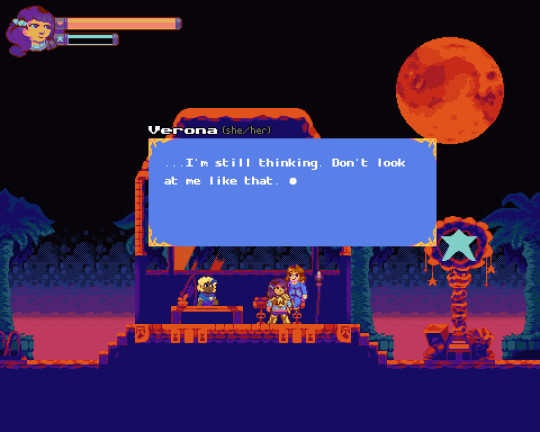
Cycle
All Lana wants is to figure out the mystery behind her mother’s death. She embarks in a Megaman Zero inspired journey into a strange tower to get her answers. Lana has a girlfriend who is a core part of the story and is prominently shown in the trailers, art and stuff. I believe I even saw her fighting side by side with her girlfriend in a boss battle in the latest trailer.
Contains: Sapphic Lead, Her Girlfriend

Thirsty Suitors
Enter the world of a Southeast Asian bisexual disatar Jala in one of the most stylish games I’ve ever played [the demo of]. It blends some fun skateboarding, with a really neat turned based RPG, and apparently even a cooking mini game into one complete package. The RPG combat is fun, funny and delightful. The story hinges on two romantic relationships that have broken down for Jala, both of whom are women, one she recently broke up with that leads her to go back to her home town and the relationship she fucked up big time in her home down with her former best friend. She battles against her not so evil exes in these RPG style mind palace fights where they resolve their feelings current and former and come to some kind of resolution.
Contains: Bisexual Lead, at least two ex girlfriends
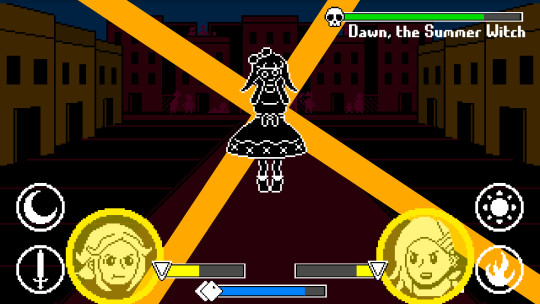
Boss Game [PC Release]
This game is already out but it has a PC release coming up and that’s amazing and great and opens the game up to more people. A pair of Girlfriends need cash and so they take gig work hunting demons but as they take the jobs they start to figure out what’s really going on and to do the right thing.
Contains: Cis Lesbian [lead], Trans Lesbian [lead], A non binary character, a bisexual character

Kitsune Tail
A mario inspired adventure about a little gay fox girl trying to save her crush from also a cute villain she might be into. It’s a super adorable platformer with a very light hearted tone invoking classic games with a modern queer twist.
Contains: Sapphic Lead, Sapphic VIllain, Sapphic Damsel
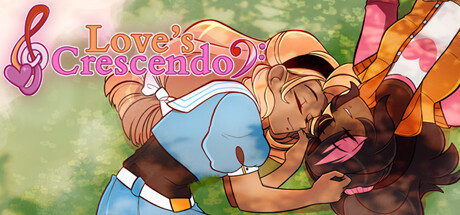
Love’s Crescendo
This is a Rhythm game visual novel hybrid about a couple of lesbians who are both doing music in their lives at this pivotal point. Valerie and Cadence complete each other, musically. This romantic musical adventure gives a lot of sweet and cute moment for these two and nice musical gameplay.
Contains: Two Lesbian of color Leads
Narrative Games
These are Visual Novels and similar games where the gameplay is mostly reading a story, maybe making choices along the way or playing a few mini games but the mini games do not comprise the core gameplay loop of the story.
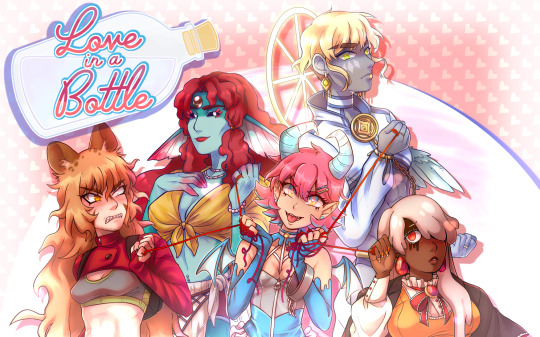
Love In A Bottle
Ankora is a lesbian love demon looking for love, in a visual novel point in click adventure she can choose to go after four different ladies. This game boasts a bit of dress up on on Ankora you can unlock while playing the game. It’s a rare dating sim where everyone is a clear adult and everyone is another kind of fantastic creature.
Contains: Let’s Go Lesbians, Let’s Go

Pen Pal Princess: A Queer Romcom Visual Novel
You play as a queer princess looking to make her own love story. This is a game about online dating in a modern fantasy setting, it’s a cute and sweet concept and feels so relevant in a world where so many queer people date long distance.
Contains: Sapphic Lead, some amount of sapphic romance options
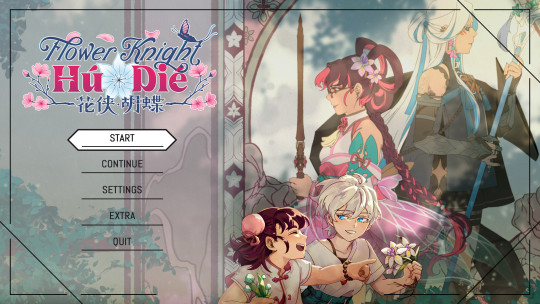
Flower Knight Hú Dié
A solar punk RPG with a lesbian main character, Hú Dié. After the Flower Knights failed her most important friend she wanted nothing to do with them but she finds herself thrown into a situation dealing with the monsters and more that infest the world.
Contains: Lesbian Lead, Sapphic Romantic Interest
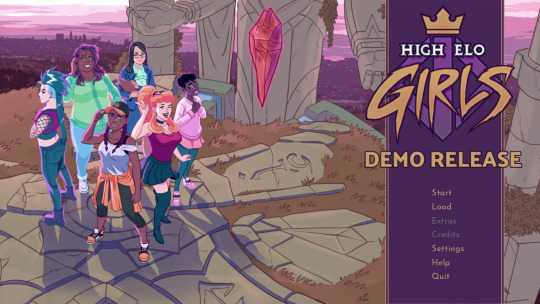
High Elo GIrls
You play as a black college dropout who gets drafted into an all women esports team. You can choose if she is Top, Jungle, Mid, DPS, or Support and the kind of relationship she has with each woman. I am not currently aware if polyamory is an option but there is some degree of customization to the relationships.
Contains: Sapphic Lead, 5 women to romance including at least 1 trans woman.

Hardcoded
You're a sexy trans girl android and you are gonna have sex with some people. There is mysterious in this cyberpunk world you gotta solve and the best solution for a service android like you is fucking your way to the top. You explore, make out with hot women, and do your thing.
Contains: Lesbian lead, Big old lesbian cast [maybe they have some other sexualities and genders]
Make Your Own Gay
This category goes over games that queerness is an option but I believe it is possible for a heterosexual who doesn’t like gay people to play the game and just kinda, miss the queerness. This is typically games where you choose to ship characters together, normally your avatar character. This places games under a pretty high bar because straight people are not very smart on the whole and are really bad at reading media critically or engaging it. For me a lot of these games are obviously queer in some way and also these games are not out, so I have no way of knowing for sure. This placement is not an insult and I actually expect several of the games in this part of the list to be some of my favorite games.
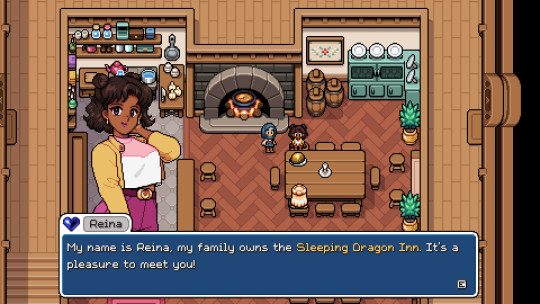
Fields Of Mistria
In this game, you start a farm in a new town, connect with local villagers learning their stories and potentially even romancing some of them, your gender does not matter. Enjoy a cozy environment of lovely people and enjoy a wonderful farming adventure. Explore dungeons, fight monsters, and more. Customize your character with a selection of appearances and customize your home and make it feel like it’s truly your own.
The games special thing is an amazing 90s anime aesthetic. It’s magic for farming system also seems particularly streamlined.
Contains: Women, Men and Non Binary characters you can romance. Customizable character.

Moonstone Island
In this game, you start a farm in a new town, connect with local villagers learning their stories and potentially even romancing some of them, your gender does not matter. Enjoy a cozy environment of lovely people and enjoy a wonderful farming adventure. Explore dungeons, fight monsters, and more. Customize your home and make it feel like it’s truly your own.
This games special thing that it has monster tamer with a really fun deck building element for your attacks.
Contains: Women, Men and Non Binary characters you can romance. Character who you can just assume is whatever gender, they are never gendered.

OVA Magica
In this game, you start a farm in a new town, connect with local villagers learning their stories and potentially even romancing some of them, your gender does not matter. Enjoy a cozy environment of lovely people and enjoy a wonderful farming adventure. Explore dungeons, fight monsters, and more. Customize your character with a selection of appearances and customize your home and make it feel like it’s truly your own.
This games special thing is that it’s kinda like pokemon and has cute little slimes.
Contains: Some women you can romance Customizable characters.

Story Of Seasons: A Wonderful Life
In this game, you start a farm in a new town, connect with local villagers learning their stories and potentially even romancing some of them, your gender does not matter. Enjoy a cozy environment of lovely people and enjoy a wonderful farming adventure. Customize your character with a selection of pronouns and appearances [She/He/They] and customize your home and make it feel like it’s truly your own.
This games special thing is that you grow old and die and get to see your kid grow up.
Contains: Women and men you can romance. Customizable character including three sets of pronouns.

Fae Farm
In this game, you start a farm in a new town, connect with local villagers learning their stories and potentially even romancing some of them, your gender does not matter. Enjoy a cozy environment of lovely people and enjoy a wonderful farming adventure. Explore dungeons, fight monsters, and more. Customize your character with a selection of pronouns and appearances [She/He/They] and customize your home and make it feel like it’s truly your own.
This games special thing is that is has online multiplayer and fairy shit.
Contains: Some Women you can romance. Customizable character including three sets of pronouns.
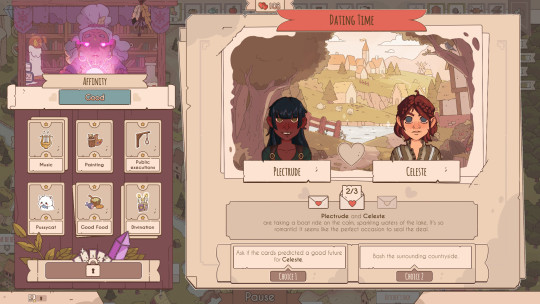
Lakeburg Legacies
A city, kingdom, town, world building type game where the game centers around pairing the people you put into your town, having them work jobs and create resources and them creating babies. You can decide what characters you want to move into your town and pair them with your gender of choice so you can filter out men totally if you don’t wanna see them [except you can’t pick babies genders]. It doesn't’ appear to have any trans stuff going on and the characters are like randomly generated silly things with a few traits. Still it’s a fun type of this game and I could see myself enjoying a few loops of it.
Contains: The ability to pair people up with the gender of your choice. You can’t control the gender of their babies.
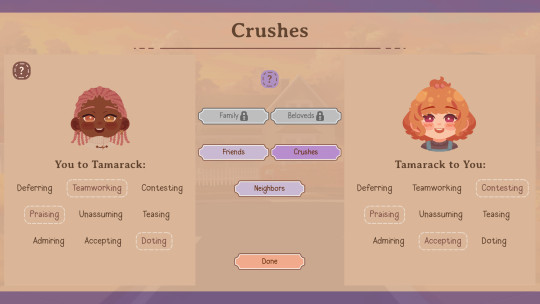
Our Life: Now and Forever
This is a truly deeply in depth life sim that trades the depth of romantic options opting for two to give you a truly ridiculous amount of customization about yourself from growing up and transitioning changing your pronouns to altering all sorts of things about yourself and relationships. This is a game about living your life from childhood to adulthood together with someone.
Contains: Genderfluid and Lady Romantic lead, your able to pick your characters pronouns, transition them during the course of the story, and more. Customizable kind of relationship dynamic from love at first sight to slow burn.

The Office Type
What if office stuff was hot, you can date that hot office stuff. It’s a dating sim where you can pick your pronouns and stuff and date all sorts of office themed hotties.
Contains: Choose your own romances and choose the genders of all the options in the game between Lady, Guy and non binary.
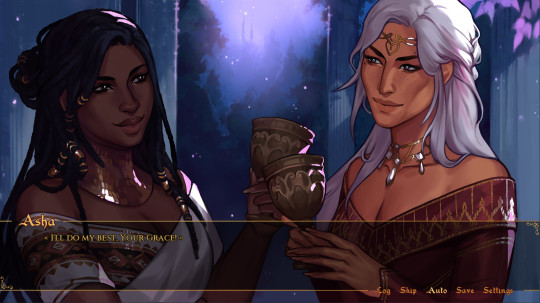
Imperial Grace
A diplomacy and romance visual novel where you make choices for your kingdom and choose who you would like to smooch.
Contains: Contains Customizable Queen, 1 lady you can romance, has a detailed list of triggers for players to be aware of what their getting into.

Solace State
A cyberpunk story about building a revolutionary movement as Chole. YOu build relationships with people and communities. Chole can hack people’s brains and get information on their thoughts. A moral system that seems to be based around your choices in not a binary way but a, how do you evaluate the ethics of doing the actions your doing to make the world better. You can make the world worse or better in the game.
Contains: 1 Lady you can romance

Call Me Under
An Eldritch Horror romance where you can pick between three sets of pronouns He/She/They and romance a collection of hotties in this 50s inspired horror world while trying to figure out about the missing people in town and the other horrors brimming of late. You can be half siren or a human depending on that things in the story will change.
Contains: Several Women and Non Binary romantic options, a Sapphic Polyamarous route, character who can pick between human and half siren and She/he/they pronouns.
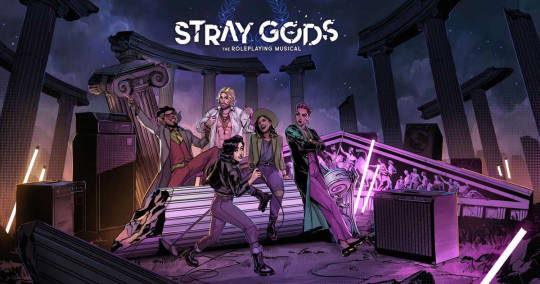
Stray Gods: The Roleplaying Musical
A muse has died and your character got her power, now the worlds a musical and you gotta solve her murder otherwise you're gonna be the one who pays for her getting killed. It’s a unique musical visual novel with a big cast of big names.
Contains: Woman Lead, two romacable women [? not confirmed], main character is probably canon bisexual but couldn't confirm in demo so here for now [but probably actually a narrative game].
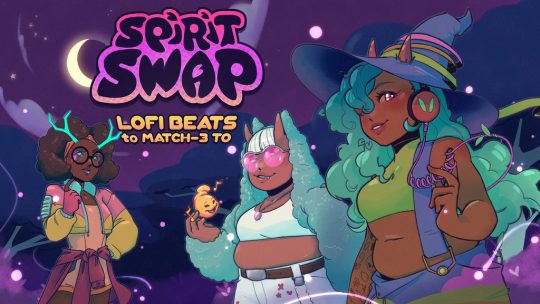
Spirit Swap
Spirits are all around us and matching 3 pops them. In this match three game you play as Samara and look for love while trying to fix the issue with the spirits in town to utterly amazing low-fi tracks. For people looking to take a break from the story of the game you can also enjoy several other mods including playing against other players.
Contains: Multiple Romantic options of varying gender including sapphic ones. Main character is probably canon bisexual but in the demo her attraction to men was a lot clearer to me then her attraction to women and I think a straight person might not catch she is gay.

Love Shore
A true cyberpunk adventure where you pick between one of two protagonists. For our purposes your Farah. This game is probably not properly a make your own gay but your not gonna get any sapphic content in one route and I think you can technically avoid it. Regardless, this game boasts a really awesome weaving plot and some sexy horric monsters you might be able to kiss too. There is some hidden stat elements which is a neat part of the game and it overall seems really cool.
Contains: Your selection of one of two protagonists, one of whom is a woman and queer. You got to choose her to get to the sapphic stuff with at least three romance options that are ladies.
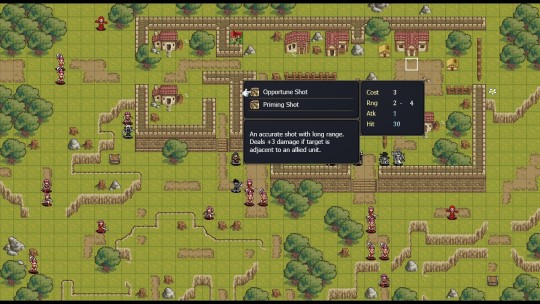
Gales of Nayeli
This game is still really early in development as far as I know so it’s hard to say how much will remain consistent but I was told directly that Nayeli and Keri could have a romance and Nayeli is the title character of the game so the main character of the story is sapphic to some extent [they also assured me it wouldn’t be the only sapphic pairing in the game]. I simply cannot judge if that is something we see in the story because we’ve not got that kind of trailer yet. There is also an avatar, one we can assume can have romances, you can pick their pronouns but not edit their appearance. This looks like a really fun strategy RPG in the vein of Fire Emblem, with grid based tactics and if your into that and want some sapphic stuff, this is one to keep an eye on.
Contains: Sapphic pairings between party members, self insert character who you can choose the pronouns of but not edit the appearances.
A Gay Exists
This Category is for games with ensemble casts, in which a sapphic character might exist in the game, be playable, be unavoidable but they are also not the focal point of the story but instead just a small part of the story. A gay does exist in this game they in theory could even be in the lead but you might not know it like a game starring Wonder Woman or Harley Quinn where in canon they might be bisexual but the game simply might avoid ever stating it.

Granblue Fantasy Relink
Set sails through the sky in a high flying action RPG with a wide cast of characters from the popular gacha series Granblue Fantasy. It features the canon bisexual icon Rossetta as a playable party member seemingly from the start of the game.
Contains: At least one playable canon bisexual. Player insert who can change genders on the fly. One playable subtextual sapphic knight.

Granblue Fantasy Versus Rising
Bullshit could or could not be blazing in this Arcsystem Works fighting game follow up expanding the cast of Granblue Fantasy Versus and the general contents of the game. We don’t know the full roster but the roster of all the last game is included giving us for sure several pieces of representation.
Contains: Two Trans women, one canon lesbian, several more subtext sapphics.
Potentially Gay
These are upcoming games I think probably will be sapphic to at least some extent in any of the above categories. Simply put, unlike the one’s above, I Am not confident enough to include them in the lists above because we simply haven’t seen any evidence to show that sapphic stuff exists. At least not in any trailer, demo, interview, or whatever that I researched when putting together this already very long list, so please be easy on me.
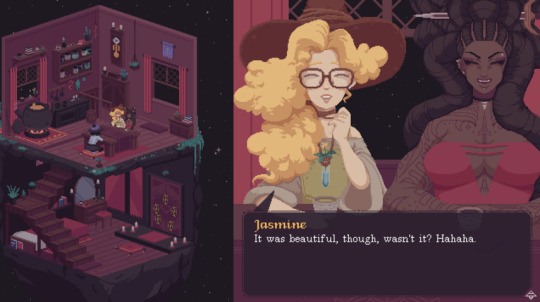
The Cosmic Wheel Sisterhood
The Cosmic Wheel Sisterhood is a card creating, fortune telling, narrative game about revenge, isolation, and more. You play as Fortuna, a witch who has been put into isolation without her magic or the ability to see anyone else by her Coven’s leader. She calls on a mystical being and makes a pact so she can get her revenge. During the game you can express romantic, sexual, etc desires and it seems like you’ll be able to craft some relationships as well as the cards.
Rune Factory 6 and Rune Factory Dragon
In these games you’ll probably be able to pick your pronouns, romance people regardless of gender, and use magic to enhance your farming. Both will likely contain dungeons with simple combat and a light action RPG story to play. You probably can get married and have kids, you maybe won’t be able to customize your character beyond picking gender but you probably will be able to customize your house.
Fantasy Life I: The Girl Who Steals Time
The first fantasy life made it where you could only be straight but at this point, Fantasy Life would be the last remaining life sim series to not let you be gay unless they totally cut out romance. I think literally the last life sim with romance to not let you be gay was like Rune Factory 4, a 3DS game. This game isn’t a farming game but it stands out next to the sims and other similar games as well.
Hades 2
The first one had a bi guy lead, I assume this time you’ll be a bi girl.
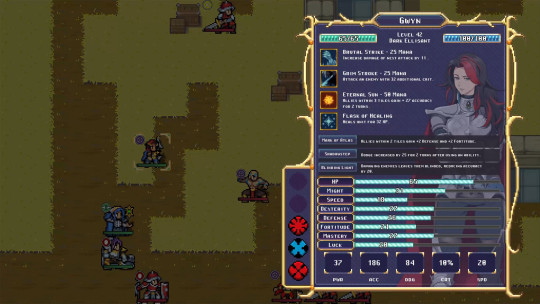
Dark Deity 2
The first one had an gays, I assume this one will have an gays as well, hopefully more, I wasn’t totally in love with how they did supports in Dark Deity 1.
Beastieball
Really this one is just vibes based, the art style says “queer” to me. Also your little beasties can start romances with each other and tehy don’t have genders but I bet you could do some making your own gay shipping with your little pokemon.

En Garde!
The vibe of the main protagonist is serving lesbian. Please Devs at Fireplace games, tell me she kisses a woman, even in private, I won’t tell anyone if I am not allowed too, the game looks fun and I just want her to kiss a girl.
---
That is all for now but if you enjoyed me doing all this research and putting it together in a really nice place for y’all then consider backing me on Patreon or Ko-fi or recommending me for work,I got my card on my page with professional contact info. Other than that you can always just follow me, reblog, share on whatever other social media sites are your poison. If you know any other sapphic games that are not yet released PLEASE let me know, want to know them all and I’m going to keep a new list after this article goes up for a few months from now when a lot more of these games are out or maybe next year around not E3 time again.
#Sapphic Video Games#Lesbian Video Games#Bisexual Video Games#LGBT Video Games#Queer View Games#LGBT+ Video Games#LGBT+#Lesbian#Sapphic#Queer#Video Games#Upcoming Games#Upcoming Queer Games#Upcoming Sapphic Games#Thirsty Suitors#Boss Game#Kitsune Tail#Love's Crescendo#Cycle#Love In A Bottle#Pen Pal Princess#Flower Knight Hu Die#High Elo Girls#Hardcoded#Gayming#Gay Games#Fields Of Mistria#Moonstone Island#OVA Magica#Story Of Seasons
75 notes
·
View notes
Text






Why New York Fashion Week is Far From Dead
In an ever-evolving world of fashion, NYFW will, in my opinion, continue to be a cornerstone of the industry. I find NYFW as far from dead, despite some conversations I’ve had that its relevance is decreasing. Based on my own experience, here's why:
NYFW is still *the* starting point for aspiring as well as seasoned designers. It features cutting-edge collections that challenge conventional wisdom every season. The Parsons exhibition never ceases to astound me. Every year, their showcase of up-and-coming designers serves as a major source of inspiration for me since it embodies unwavering commitment and passion for the art of designing.
Since its beginning, the event has seen tremendous change. Immersion experiences are now the major highlight; in a way runway shows are no longer the only thing. NYFW has embraced digital revolution, showcasing anything from virtual reality presentations to live-streamed shows. Shows these days, it seems to me, frequently adopt a more abstract approach, with prominent designers showcasing their work in exhibition-style configurations.
Some claim that the prominence of NYFW may be eclipsed by local models/influencers as a result of the growth of social media and internet platforms. But elitism in the fashion industry is nothing new. NYFW is a crucial chance for designers to land future contracts and partnerships because it continues to draw buyers, editors, and the not so liked influencers (in a way I don’t think it’s that influencers are the bad guys, who we deem celebrities forever have been terrible people, I think the admiration we hold for influencers has to be revised, having role models you personal do not know is redundant but back to the topic). It continues to have a significant influence on the cultural and economic environment of the fashion industry.
NYFW is a cultural phenomenon rather than merely a fashion event. It tackles societal issues, commemorates cultural achievements, and both reflects and defines the zeitgeist. This cultural significance guarantees that NYFW will always play a significant role in the larger discussion about identity, society, and the arts.
I’m attaching a few photos of some shows I went to as well as some of my favorite looks from this season
Parsons: Look 16
WHO DECIDES WAR
ZOE GUSTAVIA ANNA WHALEN
RIO
LAUR
#nyfw#nyfw24#nyfw2025#new york#fashion#fashion show#fashion inspiration#high fashion#parsons mfa#who decides war#laur#Zoe Gustavia Anna Whalen#upcoming#design
6 notes
·
View notes
Text
Reminder that the British aristocracy's wealth came from looting and exploiting their former colonies while doing things like pushing the Opium trade in China for example. They are just thieves, proudly parading their stolen loot. These people have no shame. The fact that these thieving, racist, xenophobic, classist aristocrats still have fans is something that amazes me daily.

Rose Hanbury, Marchioness of Cholmondeley, Accused of Possessing Looted Chinese Artifacts
After images were recently widely circulated anew from older stories in the Financial Times, Vanity Fair, and other media about Hanbury and Houghton Hall—the 18th-century estate in the Norfolk countryside where she lives with her husband David Rocksavage, the Marquess of Cholmondeley, and their three children—some social media users have taken particular note of specific pieces of oriental decor, suggesting that they may have been pillaged from China during the late Qing Dynasty, toward the end of the 19th century.
“The luxurious life of Prince William’s ‘mistress’ Rose actually came from China,” reads the title of a post last week on Xiaohongshu, an Instagram-like Chinese social media platform. According to the post—and similar ones spread across other Chinese social media platforms like Weibo and Douyin (the Chinese version of TikTok) and eventually also on the likes of TikTok, YouTube, and X (formerly Twitter)—Hanbury’s husband had inherited the furniture in question from the Sassoons (of which he is a descendant through his paternal grandmother, Sybil Sassoon).
In fact, the Sassoons, nicknamed “the Rothschilds of the East,” were a Jewish Baghdadi family that owned and oversaw a 19th-century trading empire, which grew much of its immense fortune dealing in commodities like textiles, tea, and notably opium across India, China, and beyond.
As future generations of Sassoons gravitated toward England, they officially entered the British aristocracy when the family patriarch’s son Abdallah was knighted in 1872 as Sir Albert. Since then, the Sassoons gained prominence as wealthy business owners, politicians, and friends of the royal family.
While the Sassoons played a significant role in shaping China and were avid collectors of art from around the world, it’s unclear whether they acquired specific items through purchase or pilfering. The height of their business in the country, however, coincided with China’s “century of humiliation,” which started in 1839 and ended in 1945 and was marked by the looting of millions of artifacts—most notably from the Old Summer Palace in Beijing, which was ransacked by British and French soldiers during the second Opium War.
#British Royal Family#Rose Hanbury#Marquess of Cholmondeley#Chinese artifacts#Qing Dynasty#Opium War
14 notes
·
View notes
Text
What is animanga Before Crunchyroll
This is a period in time roughly from 2005-2014 when the world is fully post-internet and Japanese anime and manga was already fully integrated into international youth culture and readily available to people outside of Japan.
Animanga fans had access via legal offline channels such as: television, home video, libraries, and bookstores. And illegal online channels such as: Youtube, pirate streaming sites, and torrenting. It is also a period with a sudden change in our general media viewing and reading habits impacted by events and technological innovations like the 2008 financial crisis, the introduction of social media as a primary way to be online, smartphones, and the slow death of live TV
Why start this period in 2005?
This page will be primarily dedicated to the English language distribution and fandom around anime and manga. By this point in time we are well beyond the stage of “evangelizing” animanga as mediums and a canon of “must watch/read” series has already been established.
The above mentioned channels were well established and readily accessible. Depending on where you lived you had a higher chance of being able to go to the bookstore and read the latest Fruits Basket volume, go to anime conventions, watch anime on TV, or join your school’s anime club, than in say 1996. The media industry in several countries outside Japan has or will soon start investing in the distribution of translated animanga for the first time ever. The US manga bubble spearheaded by Tokyopop is also still a few years from bursting.
From this point on online fan communities dedicated to anime and manga also steadily expanded via forums, database sites, to eventually meme aggregator sites, or facebook groups around 2010. In 2005 Geocities pages dedicated to sharing information are mostly dead and platforms such as Livejournal become the new place to engage in fan activities and access unofficial translations until the site was en masse abandoned following its 2009 acquisition by SUP Media
Why end this period in 2014?
Short version: 2014 is when the Naruto manga ended a mere 2 years after the Bleach anime ended its Japanese broadcast. Marking the end of the chapter on a seemingly endless period where every week without fail you could expect not just a new chapter of the manga, but a new episode of the anime version for the mega hits Naruto, One Piece, and Bleach. Kids today will thankfully never know what it was like for years have all of these series as a constant presence in 2 mediums simultaneously. This trio was controversially called the “Big 3” by fans. I could also easily leave it to the fact that of course after 9 years fans have obviously grown up and moved on and the face of the industry itself is completely different. But was just the medium that changed? What about the way international fans interacted with it? I will now present my case on why we can use the popularity of Crunchyroll as a service to make a pre- and post- era in the way international fans consumed animanga.
When the US manga bubble burst after the 2008 financial crisis there was a massive shift in which manga was licensed. The publishers that survived the collapse had to downscale their output leading series to be cancelled or go out of print for several years. The cost of manga also went up turning translated print manga into bigger investments for consumers. Another major shift is online fan translations (scanlations) becoming more prominent and accessible, with new aggregator sites appearing one by one. Not only could you read as much manga as you wanted for free with unedited art and a translation that felt more “authentic”. The high output from the fan translators revealed not just how much manga was not being licensed; the international publishers were often really far behind and much slower than the original Japanese serial.
The popularity of scanlations has always caused obvious tension to the decisions on what US publisher would license as companies like Viz Media and Vertical inc repeatedly expressed the belief that fans would never buy a title they already read for free online. It isn’t an exaggeration to say that as the fansubbers of the 1990s proved, unpaid fan translators were and still are the most significant tastemakers and gatekeepers of Japanese media for an international audience.
This sets the stage for what i personally believe forever changed the way international fans watch anime (and in turn read manga): social media and the premiere of Kill la Kill and Attack on Titan. Prior to this the average international animanga fans experienced anime rather delayed. There is little awareness of what was actually new in Japan and to the average fan watching anime recommended in online or offline communities may have been enough. But how many official channels like TV, video rentals, and home video sales were actually available as distributors went out of business or lost their licenses how was a fan supposed to watch the series they wanted to see? And what if you didn’t even live in a country with any of these official channels? Fansubs or DVD rips uploaded to Youtube, torrenting sites, or other unauthorized streaming aggregators successfully democratized access to anime for anyone with a stable internet connection. The high output of fansubbers just like scanlators also revealed again just how far behind the official channels were. Why wait for the right to purchase something when you know you want it and can just get it for free online?
Enter Crunchyroll: the site was founded in 2006 as a for-profit media hosting site for east asian media. A lot of the media hosted was unauthorized and illegal but some distributors chose to look the other way. This was until Crunchyroll started securing more and more funding in turn letting them enter legal partnerships and distribution deals. Eventually striking gold with partnership with Studio Gonzo and the acquisition of the Naruto Shippuden anime rights. Eventually all unauthorized media was removed from the site as they built a catalogue of anime for consumers to legally stream, at a price. In parallel to this, by 2012 fansubbers could and were expected to keep up with just about every new anime airing in Japan.
Another change happened in our daily lives: smartphones became a piece of technology most people owned. And the abrupt consumer shift from live TV to streaming was right around the corner.
A gradually acquired awareness of just how far behind and slow official “legal” channels were was already completely reshaping the way the most avid fans viewed anime. So was our new phones. The smartphone wasn’t just good for watching anime while you were away from home it also made reading manga online an even easier experience. How were the official distributors supposed to compete with this?
Unfortunately most pirate streaming sites were slow to implement players that functioned on smartphones, Youtube was also not far from implementing an aggressive DMCA strike system preventing new anime uploads. A service like Crunchyroll became more and more attractive as it was available in almost any region outside of Asia. With a big catalogue of titles that put Netflix and hulu to shame and a smartphone app that worked smoothly, it didn’t seem like a bad deal for people who wanted to watch anime on their phones or other devices, not to mention the premium gave you HD quality. A luxury the illegal sites couldn’t always grant. And it offered what previously only fansubbers could: you got to see brand new episodes of subtitled anime only an hour after it aired in Japan. It’s second major selling point to younger and less financially free individuals was that free users could watch as much as they wanted as long as they sat through ads, were fine with SD quality, and being 1 week behind on brand new anime.
Socially the immediacy and size of large scale social media like Facebook, Tumblr, and Twitter cultivated bigger and bigger and more public communities. It became more and more commonplace to not just watch and read whatever was recommended to you but to keep up as well as finding the next cool thing before anyone else. So what channels would keep you updated on everything new? Trustworthy sources were for many still difficult to discern. More and more fans were watching new anime at the same time as Japanese viewers via illegal and legal channels, but what would it even look like if everyone watched the same show the same time as Japanese viewers?
When Attack on Titan premiered in April of 2013 we learned. Its immediate success was unprecedented and shocking. In a matter of weeks previously unprecedented changes happened within the official channels. Not only could the US industry observe how overnight every online community was discussing this new series, Crunchyroll who streamed the series from episode 1 could provide them the actual numbers proving its success. For the first time the dub specialists Funimation would offer an unsubtitled and ongoing series for sale on iTunes. Kodansha America as well had lucked out by licensing the manga over a year prior giving the US industry another rare example of how a successful anime can give a previously niche series an unprecedented boost in sales. For fansubbers and anime and manga aggregators to keep up if a hit like this was to occur again they had to somehow work faster than Crunchyroll, or just steal from them.
Attack on Titan i think was the first time such a huge group of people all at once learned and experienced how to keep up with a brand new anime and still ongoing manga. October the same year Kill la Kill, an original story and the first work by Studio Trigger directed by the already acclaimed Hiroyuki Imaishi premiered. Once again there was an unprecedented amount of attention from international fans given to a series that was still airing in Japan. This new desire to be part of a series as it was happening was not just significant to the way international fans started viewing and evaluating anime and manga but also new opportunities for the industry to make a profit by investing more and more into “simultaneous” streaming
I didn’t read all that, sorry
Fans come to expect instant access to brand new anime and manga -> Crunchyroll is the only service able to fulfill that expectation and can do it faster than a fansubber -> in 2013 an unprecedented hit opens the eyes of the industry and anime fans alike -> now discussions and trends among international fans of anime and manga is more than ever centered around what’s “new”, a huge shift from when awareness around “newness” was vague or less relevant to how international fans interacted with animanga
How will you qualify an anime or manga as B.C. (Before Crunchyroll)
This blog and its polls will be primarily centered on the offline and online English speaking fan communities. English Second Language speakers are included in this.
Any survey will include works that received translations (official as well as unofficial) into the English language. And with consideration of these criteria
If anime: did it air on TV in the US, Canada, UK, or Australia? If so when and through which channels. Because the aforementioned delays in distribution this will matter more than when it first aired in Japan. I will continue to make 2005 my start point but exceptions might be made for series that were in some way rereleased or put in long term syndication. 2014 is the end point because of the above mentioned changes in how a lot of us watched anime was completely changed by this point in time.
Did it receive a fansub? When and by which group(s)? Identifying the groups also allows us to map out who were the tastemakers and what they wanted to make accessible to other fans. This is very key for anime that sustained popularity despite not being accessible through official channels for extended periods in the years 2005-2014. Also if you don’t live in the countries listed above it was most likely the only way you watched anime.
How often did it appear in “Anime is life” collages? (VERY IMPORTANT DATA!! how else are we supposed to quantify its cultural impact)
If manga: was it licensed by a US publisher? If so when and by who? This also matters more than when it was serialized in Japan. Viz Media’s Shojo Beat and Shonen Jump, and Tokyopop’s catalogue are very defining of the first half of this era and shaped our manga starter pack years after they stopped existing.
Did it receive a scanlation? When and which group(s)? Once again key to identifying the true tastemakers starting around 2010. Scanlations were not just key in bringing fans brand new manga hot off the Japanese presses faster than a US publisher could, but was very important in making manga that were neglected by publishers accessible in English.
Any criteria you want to suggest or already use yourself to determine eras of animanga? Or perhaps your own memories of this time? Feel free to share!!
#long post#introduction#people who were on livejournal are especially encouraged to share their experiences!!
102 notes
·
View notes
Text
The Evolution and Impact of Contemporary Art
Contemporary art, a vibrant and dynamic field, transcends traditional boundaries to explore new mediums, themes, and techniques. It encompasses artworks created from the mid-20th century to the present day, reflecting diverse cultural, social, and political landscapes. This article delves into the multifaceted nature of contemporary art, its evolution, and its impact on society.
The Evolution of Contemporary Art

Contemporary art emerged in the post-World War II era, a time marked by rapid technological advancements and significant socio-political changes. This period saw a departure from the conventions of modern art, embracing a more experimental and inclusive approach. Key movements that paved the way for contemporary art include Abstract Expressionism, Pop Art, Minimalism, and Conceptual Art.
Abstract Expressionism
Abstract Expressionism, primarily an American movement of the 1940s and 1950s, emphasized spontaneous, automatic, or subconscious creation. Artists like Jackson Pollock and Mark Rothko focused on expressing emotions and ideas through abstract forms and bold colors. This movement laid the groundwork for future artists to explore new ways of conveying meaning beyond traditional representation.
Pop Art
In the 1960s, Pop Art emerged as a reaction to the elitism of Abstract Expressionism. Artists like Andy Warhol and Roy Lichtenstein drew inspiration from popular culture, mass media, and consumerism. Their works often featured everyday objects, celebrities, and advertisements, challenging the distinction between "high" and "low" art.
Minimalism and Conceptual Art
Minimalism and Conceptual Art, emerging in the late 1960s and 1970s, further expanded the boundaries of contemporary art. Minimalist artists like Donald Judd and Agnes Martin focused on simplicity, using geometric forms and industrial materials. Conceptual artists like Sol LeWitt and Joseph Kosuth emphasized ideas over aesthetic value, often creating works that required audience interaction or interpretation.
Themes and Techniques in Contemporary Art
Contemporary artists continue to explore a wide range of themes and techniques, often addressing critical issues such as identity, globalization, technology, and the environment. Their works challenge viewers to rethink their perceptions and engage with complex social and political narratives.
Identity and Representation
Identity is a recurring theme in contemporary art, with artists exploring race, gender, sexuality, and cultural heritage. For instance, Kehinde Wiley's vibrant portraits celebrate Black identity, while Cindy Sherman's self-portraits challenge traditional notions of femininity and self-representation.
Globalization and Technology
The impact of globalization and technology on society is another significant theme. Artists like Ai Weiwei and Hito Steyerl examine the implications of digital culture, surveillance, and the global flow of information. Their works often incorporate digital media, video, and interactive installations, reflecting the increasingly interconnected world.
Environmental Concerns
Environmental issues are also prominent in contemporary art. Artists like Olafur Eliasson and Agnes Denes create works that highlight the urgency of climate change and the human relationship with nature. These pieces often use natural materials and immersive installations to foster a deeper connection with the environment.
The Impact of Contemporary Art on Society
Contemporary art plays a crucial role in shaping cultural discourse and fostering social change. By addressing pressing issues and challenging societal norms, contemporary artists encourage critical thinking and inspire action.
Cultural Dialogue
Contemporary art facilitates cross-cultural dialogue, promoting understanding and empathy among diverse communities. Exhibitions and biennials, such as the Venice Biennale and Documenta, bring together artists from around the world, creating platforms for cultural exchange and collaboration.
Social Activism
Many contemporary artists use their work as a form of social activism, raising awareness about human rights, social justice, and political oppression. For example, Banksy's provocative street art and JR's large-scale photographic installations draw attention to marginalized communities and global inequalities.
Public Engagement
Contemporary art often extends beyond traditional gallery spaces, engaging with the public in innovative ways. Public art installations, participatory projects, and community-based initiatives create opportunities for people to interact with art in their everyday lives, fostering a sense of collective ownership and participation.
Conclusion
Contemporary art, with its diverse range of themes, techniques, and perspectives, reflects the complexity of the modern world. It challenges conventional boundaries, fosters cultural dialogue, and encourages social change. As we continue to navigate an ever-evolving landscape, contemporary art remains a powerful tool for understanding and engaging with the world around us.

7 notes
·
View notes
Text
Complex feelings on A.I. art
I admit as an analog artist my feelings on AI are mixed. I know AI will not replace fine art. AI could not make the Grapefruit Book, or Abramovic's Rythym 0, or The Fountain. In fact, if you're at all active in the art world, you've probably been seeing work that uses AI for a number of years now. I remember a kid in my graduating class did project using porn screenshots to make AI generated images of genitals and sex. The images were amorphous and fleshy, I found them interesting from gender neutral perspective (though that wasn't the artist's intended angle of exploration.) I had some friends who found them distasteful but it had nothing to do with use of AI. I say this because many arguments against AI art boil down to seeing it as a "perversion" of art, some unnatural advancement that will kill art. This is always bullshit and is the same argument non-artists have been using against modern art for over a century.*
That being said, I see a lot of prominent leftist bloggers on this site celebrating AI art, or at least fighting tooth and nail against any detractors, and they never once engage with the perspective of digital artists. I follow many digital artists across many platforms (and know a number in person) and not one of them is pro-AI that scraps and regurgitates their work for profit. I can't believe this needs to be said but most artists, even fine artists, are not wealthy from their work, regardless of whether they are popular or have "made it." This actually goes doubly for commercial artists, a category many digital artists fall into. Artists having rights to their own work and labor is a political and economic issue. Regardless of where to you fall on the spectrum I think this is worth discussing, and if your discussions don't include digital artists I think they're a bit, ahh, shit.
Onto the complexity. I find it difficult to throw my weight behind legal action as the proper response. I'm wary of copyright laws, because, like all laws, they will usually be used to screw over the least powerful person in the situation. This person is much more likely to be an independent digital artist that the mogul stealing from them. I'm also extremely averse to censorship and any censorship laws. Censorship is an enemy of art and allowing the government to regulate artistic subject matter is always bad. (I can imagine a situation in which AI companies are regulated, or perhaps their ability to profit from AI is restricted? But idk I'm rather iffy and unconvinced on the usefulness regulation one way or the other.)
*Art has been dead since the Dadaists killed it, and art isn't going anywhere. The panic over AI art replacing "real" art is strikingly similar to the panic in the early 1800's when photography was invented. People thought it was going to replace painting forever, after all, why would anybody make or purchase a painting when photorealism is at your finger tips? Well, turns out painting is fine. The indomitable need to connect with other human's though art isn't going anywhere, even if painting has been tired since the death of marat.
15 notes
·
View notes
Text
A seaside hotel and former bank offices on the Isle of Man have been used by scammers conning victims in China out of millions of dollars, a BBC World Service investigation has found.
The dining room and lounge at the Seaview Hotel in Douglas were packed with dozens of Chinese workers, we have been told, on computers hooked up to fast broadband. A specialist wok hob had also been delivered to the hotel’s kitchen.
The deception, which happened between January 2022 and January 2023 according to Chinese court documents, used a method known as "pig-butchering". It is so-called because the process of “fattening the pig” - gaining the victim’s trust - is vital to its success.
The BBC spent nearly a year establishing how the investment scam was carried out from the island, which is a British Crown dependency with an independent government.
We also uncovered other details, such as how bosses had big ambitions to build a state-of-the-art office complex overlooking the Irish Sea.
As well as obtaining court papers, we have accessed leaked documents and spoken to company insiders.
One former member of staff, Jordan [not his real name], told us he had no idea of the murky world he was entering when he arrived on the Isle of Man. He says he was relieved to have found what he thought was a stable administrative job.
He did notice, however, that his new employer seemed quite secretive - for example, he and his colleagues were forbidden from taking photos at company social events. What he says he didn’t realise was that many of his Chinese colleagues were actually scam artists.
In late 2021, nearly 100 people had been transferred to the Isle of Man to work for a company which Chinese court documents refer to as "MIC". They had come from the Philippines where they had worked for another scamming firm. The BBC has discovered that MIC stands for Manx Internet Commerce.
On the Isle of Man, MIC was part of a group of associated companies - all with the same owner.
An online casino, run by King Gaming Ltd, was the most prominent. In mainland China, gambling is illegal. Setting up halfway around the world meant the group's founders could target Chinese customers, but also take advantage of the Isle of Man’s low gambling taxes.
A few months after being based at the Seaview Hotel in Douglas, the MIC workers were moved to former bank offices on the east side of town.
And this is where Jordan says he would hear sporadic cheering from his new colleagues - who worked in groups of four. He now believes they were celebrating moments when they had successfully scammed another victim, some 5,000 miles away.
Six people who worked for MIC in Douglas have now been convicted - upon their return home to China - of carrying out investment scams against Chinese citizens.
The cases, heard in late 2023, detail the illicit money stream. Victims were lured by the defendants and their accomplices from bases on the Isle of Man and in the Philippines, according to the Chinese court papers.
They say the defendants would work in teams to pull Chinese investors into chat groups on QQ - a popular Chinese instant messaging service similar to WhatsApp. One scammer would play the role of an investment "teacher", and others would pretend to be fellow investors.
The BBC has seen evidence - including in the court papers - that many of those who arrived in Douglas from the Philippines were engaged in the scams. All used the same computer equipment, depended on QQ for their work and, with the exception of a few managers, all held the same job title.
The fake investors would build an atmosphere of hype and excitement around the money-making skills of the "teacher", who would then tell the victim to put money into a particular investment platform, the Chinese court found.
Dazzled by the hype, the victim would comply, only for their funds to be syphoned off by the scammers, who actually controlled these platforms and could manipulate them from behind the scenes.
The Chinese court said it was difficult to verify the victims' total losses - but it said 38.87m renminbi (£4.17m/$5.3m) had been taken from at least 12 victims.
Relying on evidence including the defendants’ own confessions, as well as travel and financial records and chat logs, the court found the six defendants guilty.
This was not only a profitable but also a sophisticated scam, say the court documents, requiring front line teams to deploy the "pig-butchering" techniques with persuasiveness and skill.
The BBC has discovered the identity of the companies' sole beneficiary. His name was hidden behind layers of administrative paperwork.
MIC and its affiliate companies were all held by a trust set up by an individual named "Bill Morgan" who, documents show, was also known as Liang Lingfei. Employees called him "Boss Liang", says Jordan.
The Chinese court papers refer to a man called Liang Lingfei being the co-founder of MIC on the Isle of Man - which it described as "a fairly stable criminal organisation established in order to carry out scam activities". Mr Liang was not one of those prosecuted or represented at the hearings.
The court stated that Mr Liang was also co-founder of the scamming organisation in the Philippines. The BBC has seen evidence that many MIC employees worked there before being transferred to the Isle of Man.
Our investigation has also found that Mr Liang obtained an Isle of Man investment visa and attended multiple company events on the island. His wife also owns a home in the town of Ballasalla, near the island’s airport.
The group of companies on the Isle of Man was ambitious, having signed a planning agreement late last year for a glitzy "parkland campus" headquarters on the site of a former naval training base. A spokesperson for the developers described it as the "largest single private investment in the Isle of Man".
Architects’ images show office buildings set on a hill above the seafront in Douglas. Inside would have been penthouse apartments, a spa, multiple bars and a karaoke lounge.
The campus was to be used by MIC staff and those working for MIC's "affiliate" companies, including those involved in online gambling, planning documents state.
Conservative estimates put the global annual revenues of the "pig-butchering" industry at more than $60bn (£46.5bn).
"This is the first such case we've seen of one of these [pig-butchering] scam operations setting up in a Western country," says Masood Karimipour, South East Asia representative at the UN Office on Drugs and Crime.
Trying to stop the scams is like a "game of whack-a-mole", he says, and it is a battle that "organised crime is currently winning" as criminals engage in what he calls "jurisdiction shopping" where they perceive there to be legal loopholes and little oversight.
Any ambitions the group of companies may have had on the Isle of Man - legitimate or otherwise - appear to have come to an end.
In April, police raided the former bank offices. They also targeted an address next to the island's Courts of Justice building - using a ladder to enter through a first-floor window in the early hours of the morning.
In a statement released shortly afterwards, police said the raids had been in connection with a wider fraud and money laundering investigation in relation to King Gaming Ltd IOM. Seven people had been arrested and released on bail, they added.
Since then, a further three people are known to have been arrested.
Receivers were appointed earlier this month for companies in the group - including MIC and King Gaming Ltd IOM - at the request of the Isle of Man's attorney general.
The island's gambling regulator has stripped MIC's gambling affiliate companies of their licences.
The parkland campus site was cleared of trees and signage went up - but the redevelopment is now on hold indefinitely.
The BBC has made repeated attempts, via several methods of communication, to contact the companies involved - as well as Bill Morgan/Liang Langfei and company directors - but has received no replies.
We have also attempted to contact the Seaview Hotel, but have received no response, though there is no suggestion that anyone there was aware of any illegal activities taking place on the premises.
4 notes
·
View notes
Text
Just happened by chance upon the recent Penguin Classics collections of Marvel superheroes comics:
It's a relatively nice idea (terrible font choice), but as I was scrolling through the blurb for the books they put together, I couldn't help notice something that linked up all the people they'd prominently drafted in to write introductions for each of the volumes:




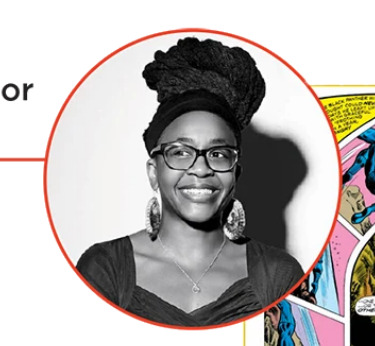
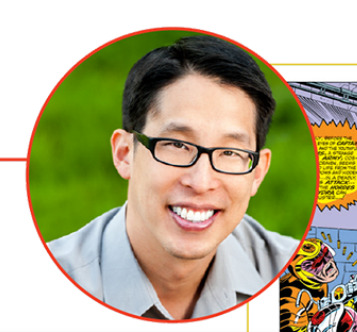
That's ALL the photos on the page, by the way: I've not cherry-picked. No pictures of Stan Lee or Jack Kirby or Steve Ditko or John Romita or any of the other writers and artists who actually dreamed up and worked their whole lives long on these timeless stories, only the random, ill-fitting, bottom-of-the-barrel-scraping mediocrities you've never heard of, chosen exclusively for their skin colour and gender, explicitly avoiding platforming any of the pale white dudes who have always cared most passionately about the artform and the fandoms and still make up the great majority of their audiences today.
Do any of those people above look like they even read comic books? How big, do you think, is their comic book collection? How many rooms of their houses are taken up with them?
If only all this repugnant race-obsessed shit were not SO. Fucking. Predictable. You know it's coming even before you click the link or read the article or turn on the TV show. You can set your watch by the bullshit. The publishing world, the media, the movie and TV industries, the education system: they've all been infiltrated and brainwashed by the far-left agenda that hates the west, hates white people and hates men. The lumpen drones who've risen to all the positions of authority within them are utterly incapable of making anything as great and universally loved as those white guys from the past they hate so much. It must eat them up terribly that all they can do is try make money off the beloved works of the past while ignoring, demeaning, downplaying or openly tearing down the great men who made them and anyone who looks like them today.
To borrow a phrase from the green activists of yesteryear: Art is not dying; it is being killed. And the people killing it have names and addresses and high-up jobs at corporations you can boycott and refuse to give your money to. So that's what I will choose to do.
18 notes
·
View notes
Text
Game Spotlight #2: Mother/Earthbound Beginnings (1989)
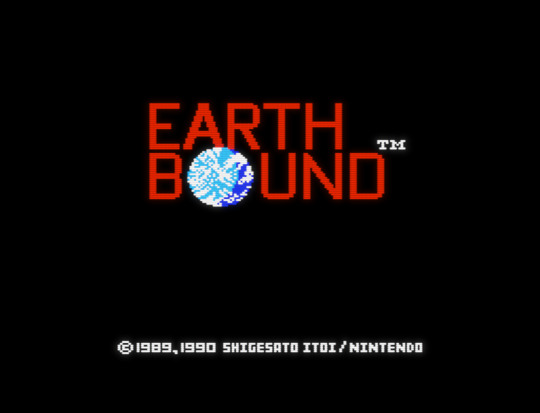
Inspired by the Japanese release of Mother 34 years ago this week, Ash gives one of her favorite games a (very long) feature on Acquired Stardust! Much has been made of its difficulty, though modern advancements in emulation including ROM hacks (in particular we recommend the excellent 25th Anniversary Edition) and a wonderful release as part of Nintendo Switch Online’s selection of classic game offerings have reduced this particular pain point (that may or may not exist in the first place!) and provide excellent entry points into one of 1989′s, and all of gaming’s, most enduring icons.
An eerie low synth is quickly met by a gentle sequence of piano keys as the phrases ‘produced by Nintendo’ and ‘presented by Shigesato Itoi’ appear across the screen. It is at once lonely and beautiful sound that matches with the logo containing a shot of Earth from space, and it sets the tone perfectly for what is to follow after being prompted to name several characters. A text scroll begins describing an unsettling story taking place in the early 1900s, 80 years before the events of the game, set in rural America, and it is here at this incredibly early point where it starts to become abundantly clear that this game is decidedly different than many other games of its time and platform. Indeed, a clue in the very first few seconds of the game practically call it out - we have a name prominently associated with this game.
It’s hard to imagine now, but video games were not always this way. Industry wide, credit was a rare thing for developers to receive and they often resorted to pseudonyms, the identities of which they allude to often being lost to time, and often were explicitly disallowed from being credited. In fact, two of the largest video game publishers today (namely Activision and Electronic Arts) were founded in part due to frustrations with companies such as Atari that, in an effort to reduce individual footprints on games and therefore make their talent less likely to be poached by rivals, did exactly that. Nintendo luminary Shigeru Miyamoto isn’t explicitly advertised in 1985′s Super Mario Bros. as being its creator either on the title screen or in a credits sequence at the end of the game, and even contemporary Nintendo Entertainment System role playing games of the time such as 1986′s Dragon Quest only features specific individual credits at the end of the game, and 1987′s Final Fantasy only credits the game to the company that produced it rather than any individuals in the creative process.
Mother, alternatively known as Earthbound Zero or Earthbound Beginnings in the west after its more famous namesake, 1995 Super Nintendo RPG Earthbound leads with something very much breaking in tradition of early eras of gaming in that it is explicitly, unavoidably from someone. An individual with a name. It is this that is especially striking to me before we even get to the surprisingly creepy opening text scrawl that sets up the backstory of Mother.
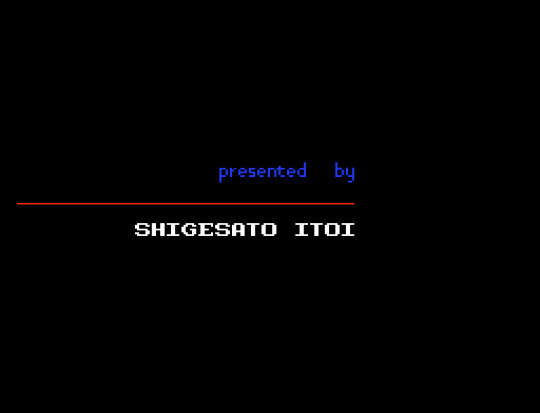
Born in November 1948, Shigesato Itoi is something of a renaissance man who became a bit of a celebrity in the incredibly unlikely position of copywriting, which is essentially another word for ‘advertising’, and one of the earlier examples of celebrity game developers in Japan that come to mind off the top of my head. Having created a number of famous ad slogans and campaigns including a 1982 anti-war ad featuring two armed soldiers standing opposite each other, beckoning their Prime Minister forward onto the front lines before them, Itoi’s ads often feature bold imagery contrasted with short phrases that manage to provoke vivid emotion in the viewer, and this maximizing of such little material makes two things abundantly clear: Itoi is not only an extremely effective communicator of ideas, but his specific skillset of utilizing images and sparse but provocative text is perfectly suited not only to video games but especially the world of NES role playing games which feature incredibly strict limitations, especially by today’s standards, though even by 1989 Japan had started to see more powerful systems such as Sega’s Mega Drive console having released a year prior. Befitting of its celebrity-via-advertising creator, Mother has one of the absolute coolest commercials I’ve ever seen with the slogan “no crying until the ending”.

Mother is a famously difficult game, for which I think it gets somewhat of an unfair reputation. While it does require copious amounts of grinding to increase one’s level and stats (as was standard for role playing games of the era and even for many years after) and see plenty of steep and extremely sudden curves in battle balance, there are no game overs in Mother. Upon defeat in battle the player will simply be returned to the last physical location at which they saved with all of their experience points acquired up to the point of defeat intact. There is no loss of items either, only a loss of money you currently have on you, which isn’t an especially big deal in part due to money not accruing in the player’s inventory by default (it is instead obtained from ATMs via a credit card at department stores) as well as the abilities protagonist Ninten unlocks through leveling up often being more useful and far less limited in use than purchasable items are. In this way there are shockingly few consequences for dying in Mother, with even many games decades later returning you to the title screen to load the data you last saved, with players who aren’t mindful of saving often being able to potentially lose hours of progress at a time. Just as well, grinding becomes significantly easier with the inclusion of additional party members and guest characters that enter the party occasionally. The only particular pain point of Mother is another common feature of role playing games of this era, where actions taken applying to an enemy who has died before said actions have occurred will miss as opposed to applying to the next enemy in the encounter.
Instead of traditional difficulty, Mother is a perfect example of games of its era in that it’s a perfect Nintendo Power game. Players are given very few directions and objectives, the world is extremely vast and dialogue with townspeople is often inane and not particularly helpful. It is very easy to become lost literally and figuratively, wondering where exactly you are in the game world (despite a rather useful map being built into the game from the start) or even what you’re meant to be doing, only to resort to a walkthrough and find out you were supposed to purchase a canary egg, hatch said canary who is described as having “sad eyes”, and return it to its mother somewhere. Suffice it to say Mother is a very cryptic game that takes the tone of a light parody of genre tropes and features a shockingly wide array of ways in which the player can interact with the world and events that can occur completely irrelevant to the actual story of the game to the point that I feel like you could make up a bizarre lie about something in the game as a playground rumor and someone would conceivably believe you no matter how outlandish it was. This is the sort of game that strongly encourages and rewards spending time with it. Getting lost in it. Having your own experience with it, and forming your own genuine connection with it.
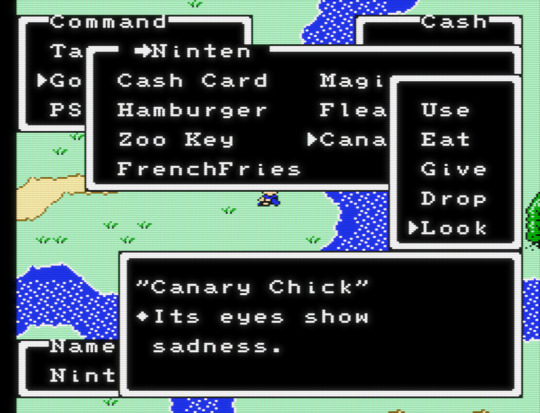
It is exactly this sort of nature that makes the game stand out so much coming from an individual as opposed to a game designed by committee. Sometimes things just happen, such as a talking penguin questioning why he came to a gathering of monkeys in an underground maze, or catching a cold from a townsperson that must be cured at a hospital. Just as well the game contains a frankly shocking level of interesting and even emotionally gripping story content (much of which does come towards the end of the game). Mother is a game unavoidably art from an individual artist and everything in the game is included because it was specifically intended by its creator, and it’s this fact permeating the entire experience that makes it so attractive to people. Aside from the scenario and general happenings of the game, composers Keiichi Suzuki and Hirokazu Tanaka provide what has my vote for the strongest soundtrack top to bottom on the entire platform, even being featured in a vocal album containing English lyrics that may be saccharine and cheesy but are also very genuine and vulnerable. Several of the songs have been used throughout the series and are easily recognizable to gamers who haven’t even ever touched the series.

A point of particular interest for me is all the similarities between Mother and Pokemon, with many people picking up on visual similarities between the final boss of Mother, Giegue, and Pokemon’s final optional battle in Mewtwo. Much of the structure of the game is also similar, with a young protagonist leaving his ostensibly single mother on a coming of age journey obviously inspired by 1986 film Stand By Me (itself based on an earlier story by Stephen King), which is also referenced pretty directly on a television set in the Pokemon protagonist’s house. Speaking of traveling, as mentioned before the world of Mother is indeed incredibly vast and much like Pokemon is both a contemporary setting (as opposed to a fantasy setting or a historical setting) and also traveled through almost completely seamlessly, whether it be on foot or by train. It is through this railway, the Paradise Line, that one can start to appreciate just how big the game world actually is. There’s even a sidequest in which Ninten must find an old man’s missing dentures, also featured in the first generation of Pokemon games. It’s an odd series of things that line up very well, and we’re not done there. Composer Hirokazu Tanaka actually ended up heading Creatures, Inc. which has worked in tandem with Gamefreak and The Pokemon Company on various aspects the Pokemon franchise since at least 1998, potentially even earlier. Just as well, Pokemon creator Satoshi Tajiri famously referring to Mother as “not very kind” in its design in an October, 1989 review, nearly 7 years before the Japanese release of the first wave of Pokemon games.
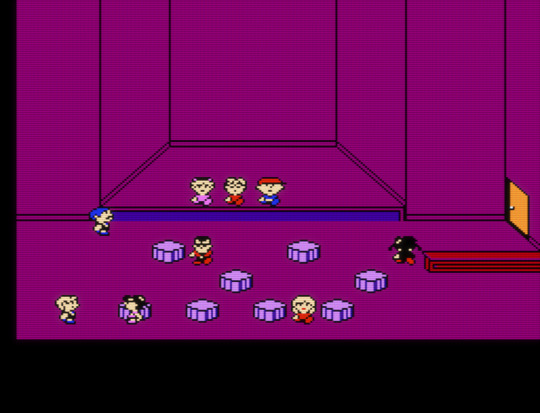
There is so much I could say about this game, and indeed so much I have already said, but the purpose of Acquired Stardust is less to give you the minute to minute plot points (particularly in story-based games, we would rather you experience these for yourself than spoil the experience for you ahead of time) and more so about giving you a recommendation. To that end I can only tell you that Mother has Acquired Stardust’s endorsement as well as my own personal endorsement. Despite its age it manages to feel shockingly modern in many ways, not the least of which due to its deep influence on the indie game scene in which ‘quirky RPG Earthbound-inspired RPG about depression’ has become a scene unto itself, and games like Yume Nikki which have made their own marks on the medium which in turn has spawned a scene unto itself.
Mother is one of the games that made gamers the world over think of game developers as artists first and foremost, a notion that largely is patently accepted in today’s scene. It features an incredible plot punching far above its weight especially in the latter half, likely the best top to bottom soundtrack on the NES, rewarding exploration, and much of the supposed difficulty is mere intimidation or remedied by emulation features such as savestates, ROM hacks, fast forwarding and rewinding.
There are plenty of misconceptions and talking points ready to assure you that Mother isn’t a very good game and that Earthbound supersedes its predecessor entirely, but that’s a very western-centric viewpoint often born of a particular fusion of recency bias and nostalgia, given that predecessor Mother was never released outside of Japan and sequel Earthbound is the title most people who know the trilogy started with, and that sentiment I promise you simply isn’t true. Both games are different enough and well worth your time, as is 2006′s Mother 3. If you have even a passing interest in video games as an art form, Mother is a vitally important divergence point between ‘games as distraction’ and ‘games as art’, and an incredible milestone for the medium. It is something that changed the way we think about games and the way we interact with them, both directly and through the countless games it’s directly influenced. Just remember: no crying until the ending!
A gem hidden among the stones, Mother is unquestionably stardust.
--Ash
#Video Games#Gaming#NES#Nintendo#Retro Gaming#Retro Games#RPG#Role Playing Games#Mother#Earthbound#Shigesato Itoi#Acquired Stardust#1989#Game Recommendations#Game Spotlights
18 notes
·
View notes
Text
The Evolution of Entertainment From Ancient Times to the Digital Era
Entertainment has always been an essential part of human culture, offering a respite from daily life and a chance to experience joy, wonder, and emotional connection. From ancient civilizations to the current digital age, Entertainment has undergone dramatic transformations, reflecting shifts in technology, culture, and society. This article explores the rich history of entertainment, tracing its roots, its evolution through various epochs, and the ways in which modern-day entertainment continues to captivate and evolve.
Ancient Beginnings of Entertainment
The desire for entertainment is as old as civilization itself. Early humans entertained themselves through storytelling, music, dance, and games. In prehistoric times, cave paintings might have served both a ritualistic purpose and an early form of visual entertainment. The ancient Egyptians held grand festivals and celebrations, filled with music, food, and dance, while the Greeks and Romans elevated entertainment to new heights with theater, gladiatorial games, and chariot races.
Theater in ancient Greece, particularly during festivals like Dionysia, showcased plays that ranged from tragedies to comedies. Playwrights like Sophocles and Aristophanes became cultural icons, and their works laid the foundation for modern drama. Meanwhile, the Roman Colosseum became a center of violent but highly popular entertainment, where gladiators fought to the death, and massive battles were recreated for the audience’s enjoyment. These events were not merely pastimes but also social rituals that bound people together in shared experiences.
Entertainment in the Middle Ages and the Renaissance
With the decline of the Roman Empire, the Middle Ages saw a shift in entertainment that reflected the era's religious and social structures. Religious ceremonies, morality plays, and festivals continued to provide entertainment, often with a strong focus on moral lessons and community engagement. Troubadours and minstrels roamed Europe, singing songs of love, valor, and adventure, which kept people connected to their cultural roots despite widespread political instability.
The Renaissance, however, marked a flourishing of the arts, and entertainment became more intellectual and varied. The printing press, invented by Johannes Gutenberg in the 15th century, revolutionized access to literature and knowledge, allowing the masses to experience stories and ideas beyond their immediate environment. Theater also grew in prominence during this period, with the works of Shakespeare, Cervantes, and Dante establishing the standards for narrative and character development that continue to influence literature and entertainment to this day.
The Rise of Mass Entertainment in the 19th and 20th Centuries
The 19th century saw the birth of new forms of entertainment designed to appeal to a wider audience. With the Industrial Revolution came a shift from agrarian societies to urban centers, leading to the rise of public spaces like theaters, opera houses, and music halls where large groups could gather to be entertained. The advent of photography and, later, motion pictures in the late 1800s revolutionized visual entertainment. The Lumière brothers’ invention of the cinematograph in 1895 gave rise to the motion picture industry, leading to the silent films of the early 20th century and later the golden age of Hollywood.
Cinema quickly became one of the most dominant forms of entertainment, offering people a glimpse into different worlds, cultures, and ideas. Stars like Charlie Chaplin, Marilyn Monroe, and James Dean became cultural icons, influencing fashion, behavior, and attitudes. Radio and, subsequently, television became the next major platforms for entertainment in the 20th century. These technologies brought music, news, and serialized dramas directly into people's homes, creating a new communal experience around entertainment.
Music, too, experienced a revolution with the invention of the phonograph and the rise of recorded sound. Jazz, rock ‘n’ roll, and pop music transformed the cultural landscape, with artists like Elvis Presley, The Beatles, and Michael Jackson shaping not just entertainment but entire cultural movements. The 20th century’s advances in technology allowed for the mass production and distribution of entertainment, making it accessible to people of all walks of life.
The Digital Era: Streaming, Social Media, and Gaming
The 21st century has brought about perhaps the most significant transformation in entertainment: the digital revolution. The internet has democratized entertainment, allowing creators from all over the world to reach global audiences. Streaming services like Netflix, YouTube, and Spotify have changed the way people consume media. No longer bound by television schedules or theater release dates, viewers can access films, TV shows, and music whenever they want, often in binge-watching marathons that were unheard of just a few decades ago.
Social media platforms like Instagram, TikTok, and Twitter have turned ordinary people into entertainers. Influencers, YouTubers, and content creators can amass huge followings, sometimes rivaling traditional movie stars or musicians. The interactive nature of these platforms allows audiences to engage directly with entertainers, blurring the line between creators and consumers.
Video games have also risen to unprecedented popularity, becoming a dominant form of entertainment. Games like "Fortnite," "Minecraft," and "The Legend of Zelda" have large, dedicated fanbases and offer immersive worlds that provide not just passive entertainment but interactive experiences. With the advent of virtual reality (VR) and augmented reality (AR), the boundaries of entertainment are being pushed even further, creating immersive experiences that were once the stuff of science fiction.
The Future of Entertainment
As technology continues to evolve, so will entertainment. Artificial intelligence (AI) is already being used to create music, write scripts, and even produce visual art, raising questions about the future of creativity and human involvement in entertainment. Virtual reality and augmented reality are likely to become even more integrated into our daily lives, offering new ways to experience stories, games, and even live events like concerts or sports.
Moreover, the rise of the "metaverse" — a collective virtual space where people can interact in real time — could radically change the way we think about entertainment. In the metaverse, entertainment won’t just be something we consume; it will be something we live inside, interacting with others in real-time virtual environments that blur the lines between reality and fiction.
In conclusion, entertainment has come a long way from the early days of storytelling around a fire to today’s immersive digital experiences. As technology and culture continue to evolve, so too will the ways in which we entertain ourselves. What remains constant, however, is humanity's deep desire for stories, music, games, and experiences that bring joy, connection, and a sense of wonder to our lives.
2 notes
·
View notes
Text
Online Treasure of Sufi and Sant Poetry
Online Treasure of Sufi and Sant Poetry
Introduction
Understanding the Essence of Sufi and Sant Poetry
Define Sufi Poetry
Define Sant Vani
Importance and relevance in modern times
Sufi/Sant Poetry: A Rich Heritage
Historical Background
Origins of Sufi Poetry
Development of Sant Vani
Famous Sufi Poets and Their Contributions
Bulleh Shah
Rumi
Amir Khusro
Renowned Sant Poets and Their Works
Kabir
Tulsidas
Guru Nanak
Sant Vani: The Spiritual Songs
Definition and Importance of Sant Vani
Connection with spirituality and daily life
Prominent Themes in Sant Vani
Love
Devotion
Humanity
Notable Compositions in Sant Vani
Kabir's Dohas
Guru Nanak's Bani
Tulsidas' Ramcharitmanas
Sufi Qawwalis: The Soulful Melodies
Origins and Evolution of Qawwali
Historical context and cultural significance
Famous Qawwals and Their Contributions
Nusrat Fateh Ali Khan
Sabri Brothers
Abida Parveen
Impact of Qawwalis on Society
Influence on music and cinema
Role in spiritual gatherings
Sufi Kalam: The Divine Verses
Meaning and Importance of Sufi Kalam
Spiritual and philosophical insights
Key Figures in Sufi Kalam
Rumi
Hafez
Shah Hussain
Popular Sufi Kalam Collections
Mathnawi by Rumi
Diwan-e-Hafiz
Heer Ranjha by Waris Shah
E-Books: Accessing the Treasure
Availability of Sufi and Sant Poetry E-Books
Benefits of digital access
Top Online Platforms for Sufi and Sant E-Books
Sufinama
RekhtaBooks
Project Gutenberg
Recommended E-Books for Sufi and Sant Poetry
"The Essential Rumi" by Coleman Barks
"Songs of Kabir" by Rabindranath Tagore
"The Conference of the Birds" by Attar of Nishapur
Conclusion
The Continuing Relevance of Sufi and Sant Poetry
Modern interpretations and adaptations
Influence on contemporary literature and art
Exploring Further
How to engage with and study Sufi and Sant poetry
Online resources and communities
Example Content Sections:
Understanding the Essence of Sufi and Sant Poetry
Sufi and Sant poetry are two deeply spiritual and philosophical traditions that have enriched the cultural and literary heritage of South Asia and beyond. Sufi poetry, often associated with mysticism and the quest for divine love, is known for its profound depth and emotional resonance. Sant Vani, on the other hand, comprises the devotional songs of the Sant tradition, emphasizing ethical living, devotion to God, and social equality.
These poetic forms have not only provided spiritual solace to millions but have also acted as a medium for social reform, challenging rigid societal norms and advocating for a more inclusive and compassionate worldview.
Famous Sufi Poets and Their Contributions
Bulleh Shah
Bulleh Shah is one of the most celebrated Sufi poets whose verses transcend the boundaries of time and culture. His poetry, written in Punjabi, is a testament to his profound spiritual journey and his quest for unity with the Divine. Bulleh Shah’s works, such as "Bulleya Ki Jaana Main Kaun," are timeless classics that continue to inspire and resonate with readers around the world.
Rumi
Jalal ad-Din Muhammad Rumi, more commonly known as Rumi, is perhaps the most famous Sufi poet in the world. His works, written in Persian, have been translated into numerous languages and are widely read across the globe. Rumi’s poetry, encapsulated in his magnum opus "Masnavi," explores themes of divine love, the soul’s journey towards God, and the nature of existence.
Amir Khusro
Amir Khusro, a prolific Persian poet and a disciple of Nizamuddin Auliya, made significant contributions to Sufi literature and music. He is often credited with the invention of several musical instruments and the development of new genres of poetry. His ghazals and qawwalis are integral to the Sufi musical tradition and continue to be performed with great reverence.
Prominent Themes in Sant Vani
Sant Vani, the poetic expressions of the Bhakti saints, often revolve around themes of love, devotion, and social justice. The Bhakti movement, which gave rise to Sant Vani, sought to transcend the barriers of caste and creed, promoting a direct and personal relationship with the Divine.
Love and Devotion
The Bhakti saints, such as Kabir and Guru Nanak, emphasized the importance of love and devotion in their teachings. Kabir’s dohas (couplets) are renowned for their simplicity and profound wisdom, urging individuals to seek the Divine within themselves and to practice love and compassion in their daily lives.
Humanity and Social Equality
The Bhakti poets often used their verses to challenge societal norms and advocate for social justice. Guru Nanak, the founder of Sikhism, composed hymns that spoke against the caste system and gender discrimination, promoting the ideals of equality and universal brotherhood.
Famous Qawwals and Their Contributions
Qawwali, a form of Sufi devotional music, has a rich history and a profound impact on South Asian culture. This genre, characterized by its repetitive and hypnotic melodies, is designed to induce a state of spiritual ecstasy and divine connection.
Nusrat Fateh Ali Khan
Nusrat Fateh Ali Khan is often hailed as the greatest qawwal of all time. His powerful voice and emotive renditions of Sufi poetry have captivated audiences worldwide. His contributions to qawwali music have not only preserved this ancient tradition but also brought it to the global stage, influencing musicians across various genres.
Sabri Brothers
The Sabri Brothers, a legendary qawwali group from Pakistan, are known for their dynamic performances and soulful renditions of Sufi poetry. Their qawwalis, such as "Bhar Do Jholi Meri" and "Tajdar-e-Haram," are celebrated for their spiritual fervor and emotional depth.
Abida Parveen
Abida Parveen, one of the most iconic female Sufi singers, has made significant contributions to the world of Sufi music. Her powerful and evocative voice has brought the poetry of Sufi saints to life, making her one of the most revered figures in the genre.
Recommended E-Books for Sufi and Sant Poetry
For those looking to delve deeper into the rich traditions of Sufi and Sant poetry, numerous e-books are available online. These digital collections provide a convenient way to explore the profound wisdom and spiritual insights of the Sufi and Bhakti poets.
"The Essential Rumi" by Coleman Barks
This renowned translation of Rumi’s poetry by Coleman Barks captures the essence of Rumi’s mystical and spiritual insights. The book includes some of Rumi’s most famous poems, making it an essential read for anyone interested in Sufi literature.
"Songs of Kabir" by Rabindranath Tagore
Rabindranath Tagore’s translation of Kabir’s dohas brings the profound wisdom of this Bhakti saint to a global audience. The book offers a selection of Kabir’s most insightful and thought-provoking verses, providing a glimpse into his spiritual teachings.
"The Conference of the Birds" by Attar of Nishapur
This classic Persian poem, written by the Sufi poet Attar of Nishapur, is an allegorical journey of the soul towards enlightenment. The book, available in various translations, is a profound exploration of Sufi philosophy and spiritual quest.
#Read Sant Vani written by famous Sant Poets. Sant Vani of Meerabai#Raskhan#Rahim and many more in Urdu#Hindi and Roman scripts.
3 notes
·
View notes
Text
Understanding Java: A Comprehensive Guide for Beginners and Pros
In the ever-expanding landscape of programming languages, Java stands as a stalwart, renowned for its versatility, reliability, and scalability. Whether you're an aspiring coder taking your first steps into the world of programming or a seasoned developer looking to broaden your skill set, Java presents a vast and captivating journey of discovery. This comprehensive guide aims to provide you with a roadmap for mastering Java effectively, offering insights, strategies, and resources to empower your learning process.

Java's prominence in the tech industry cannot be overstated. Its cross-platform compatibility, robustness, and extensive libraries make it a top choice for a wide range of applications, from web development to mobile app creation and enterprise-grade software solutions. With Java as your programming language of choice, you're embarking on a learning journey that can open doors to diverse and rewarding opportunities in the software development field.
Whether you're just beginning your Java journey or seeking to enhance your existing skills, this guide is your compass, pointing you toward the resources and strategies that will enable you to thrive in the world of Java development. So, let's embark on this adventure together, as we unlock the power of Java and take your coding skills to new heights.
The Fundamentals: Starting with the Basics
At the heart of mastering Java lies a strong grasp of its fundamentals. To begin your Java journey, you must dive into the basics. Start by understanding variables, data types, operators, and control structures, including loops and conditionals. These are the building blocks of Java programming and serve as your foundation. Fortunately, there's a wealth of online tutorials, textbooks, and courses available to help you comprehend these essential concepts.
The Power of Object-Oriented Programming (OOP)
Java is often celebrated for its object-oriented programming (OOP) paradigm. Delve into the world of OOP, where concepts like encapsulation, inheritance, polymorphism, and abstraction are fundamental. These principles are crucial for writing clean, maintainable, and scalable Java code. A strong grasp of OOP sets you on the path to becoming a proficient Java developer.
Practice Makes Perfect: The Art of Coding
Programming is a skill that thrives with practice. To truly master Java, you must write code regularly. Start with small projects and gradually work your way up to more complex challenges. Experiment with different aspects of Java, refine your coding style, and embrace the iterative process of development. Platforms such as LeetCode, HackerRank, and Codecademy offer a plethora of coding challenges that can sharpen your skills and boost your confidence.
Harnessing the Java Ecosystem: APIs and Libraries
Java boasts a vast standard library, replete with pre-built classes and methods. Familiarize yourself with these libraries as they can significantly streamline your development process. By leveraging these resources, you can save time and effort when building applications. Whether you're developing desktop applications with JavaFX, web solutions with Spring Boot, or mobile apps using Android Studio, understanding the Java ecosystem is indispensable.
Memory Management: The Key to Efficiency
Java employs automatic memory management through garbage collection. To optimize performance and prevent memory leaks, it's essential to grasp how memory is allocated and deallocated in Java. Understanding the intricacies of memory management is a hallmark of a proficient Java developer.
Building Real-World Projects
Theory alone won't make you a Java expert. Building practical applications is one of the most effective ways to learn Java. Start with modest projects and gradually increase their complexity. This hands-on approach not only reinforces your understanding but also equips you with real-world experience. Develop desktop applications with JavaFX for intuitive user interfaces, craft robust web applications using Spring Boot, or dive into the world of mobile app development with Android Studio. The projects you undertake will serve as a testament to your Java prowess.
The Power of Java Books: In-Depth Knowledge
Consider supplementing your practical experience with authoritative Java books. "Effective Java" by Joshua Bloch and "Java: The Complete Reference" by Herbert Schildt are highly recommended. These books provide in-depth knowledge, best practices, and insights from seasoned Java experts. They are invaluable resources for expanding your understanding of Java.
Enriching Your Learning Journey: Online Courses and Tutorials
Online courses from reputable platforms like Coursera, Udemy, edX, and ACTE Technologies can accelerate your Java learning journey. These courses offer a structured approach, with video lectures, assignments, and quizzes to reinforce your knowledge. ACTE Technologies, in particular, stands out for its expert instructors and comprehensive curriculum, providing you with valuable insights into the world of Java development.
Engaging with the Community: Online Forums and Communities
Joining Java forums and communities is an excellent way to complement your learning. Platforms like Stack Overflow, Reddit's r/java, and Java-specific LinkedIn groups provide a space to ask questions, seek guidance, and share your knowledge. Engaging with the Java community not only helps you find answers to your queries but also keeps you updated on the latest industry trends and best practices.
Staying Current: Java's Evolution
Java is a dynamic language that evolves over time. To remain at the forefront of Java development, it's essential to stay updated with the latest Java versions and features. Follow industry-related blogs, newsletters, and social media accounts. Keeping abreast of these changes ensures that your Java skills remain relevant and in demand.

In conclusion, embarking on the journey to master Java is an exciting and rewarding endeavor that demands dedication and continuous learning. The world of Java programming offers a multitude of opportunities, from web development to mobile app creation and enterprise solutions. By following the comprehensive roadmap outlined in this blog, you can pave the way to becoming a proficient Java developer.
Remember, learning from reputable sources such as ACTE Technologies can provide you with the knowledge and expertise needed to excel in Java programming. ACTE Technologies' exemplary Java courses, led by expert instructors and featuring a comprehensive curriculum, can help you establish a strong foundation and advance your Java skills. As you embark on your Java learning journey, may your passion for coding and commitment to excellence lead you to success. Good luck!
8 notes
·
View notes